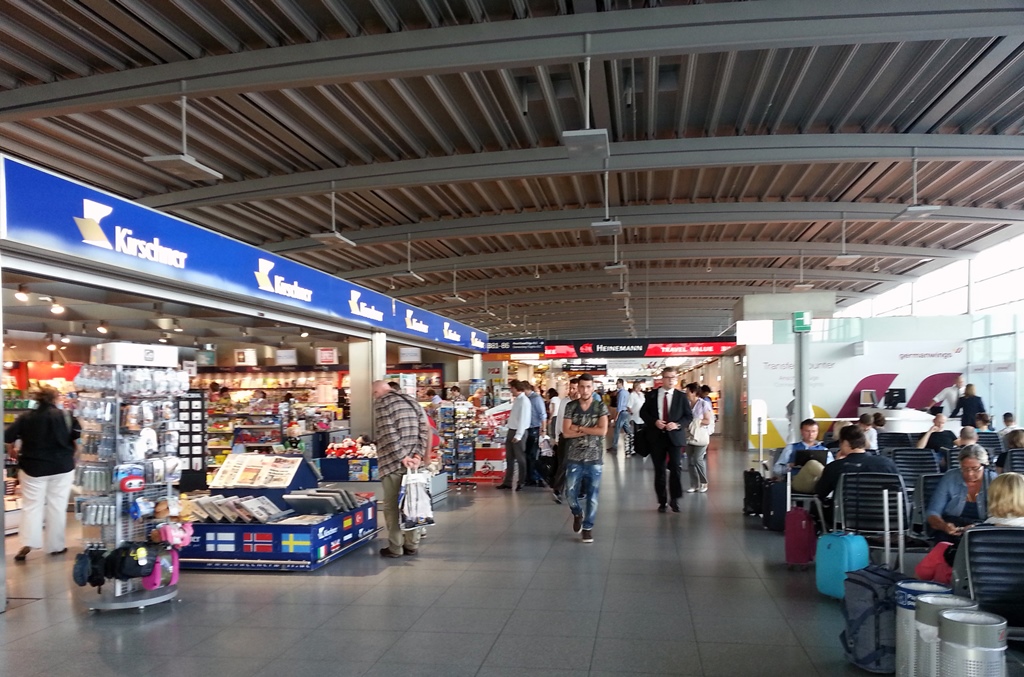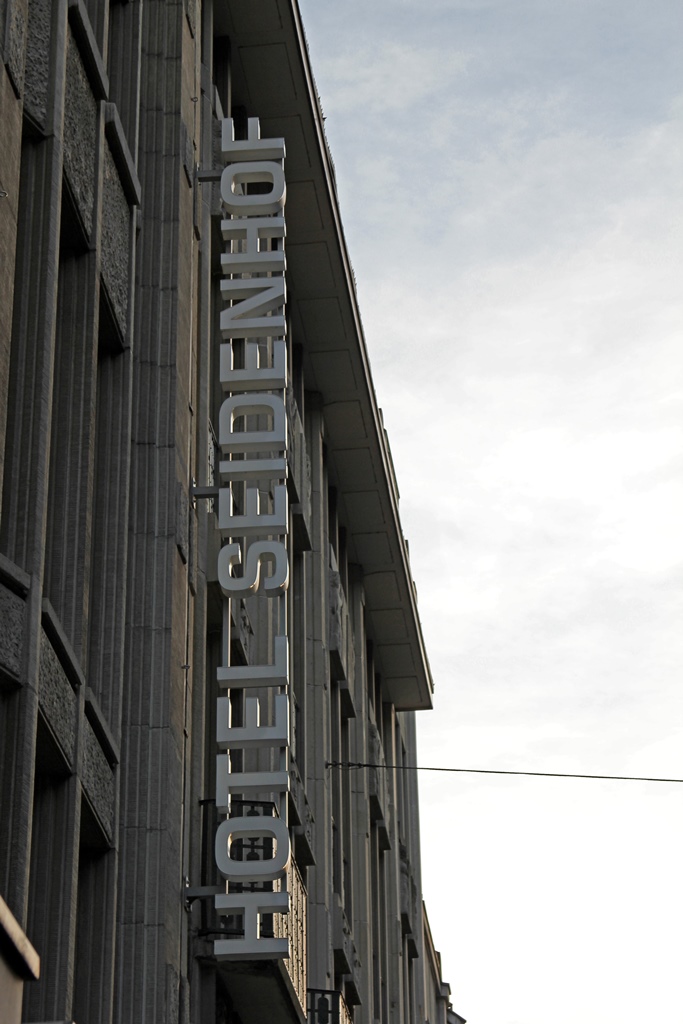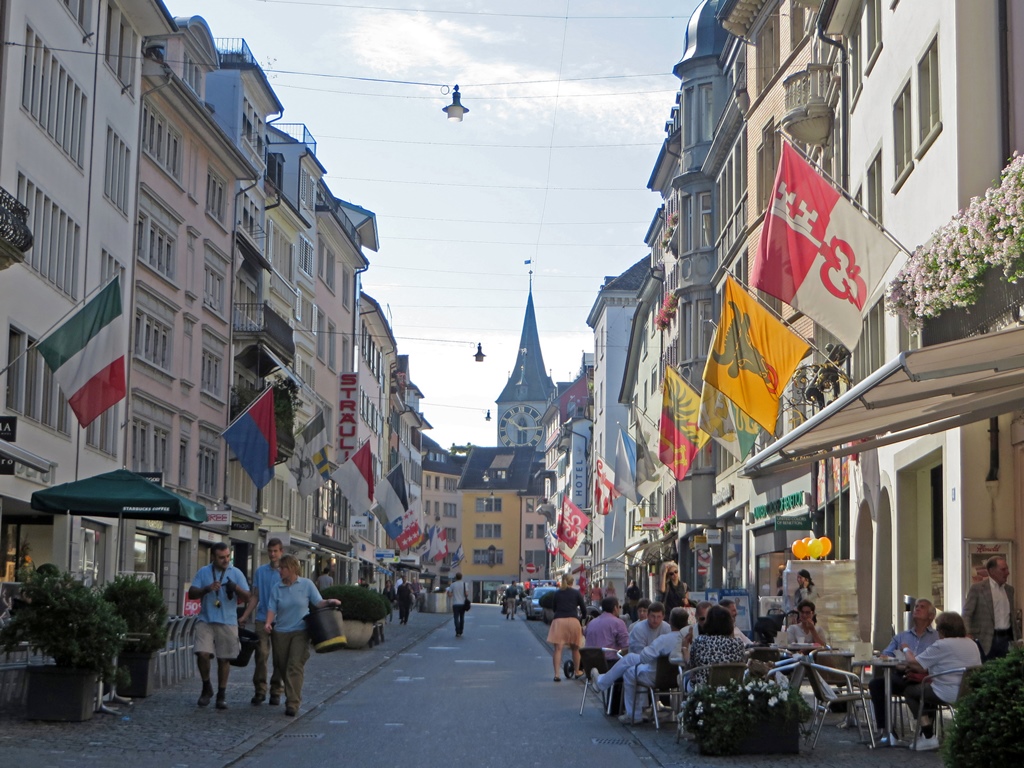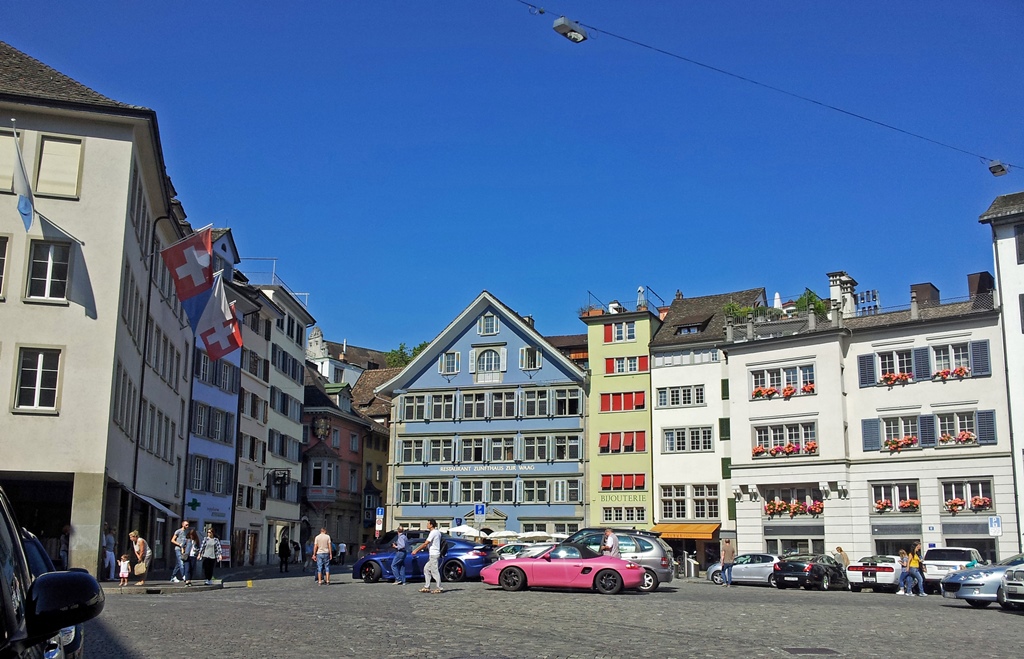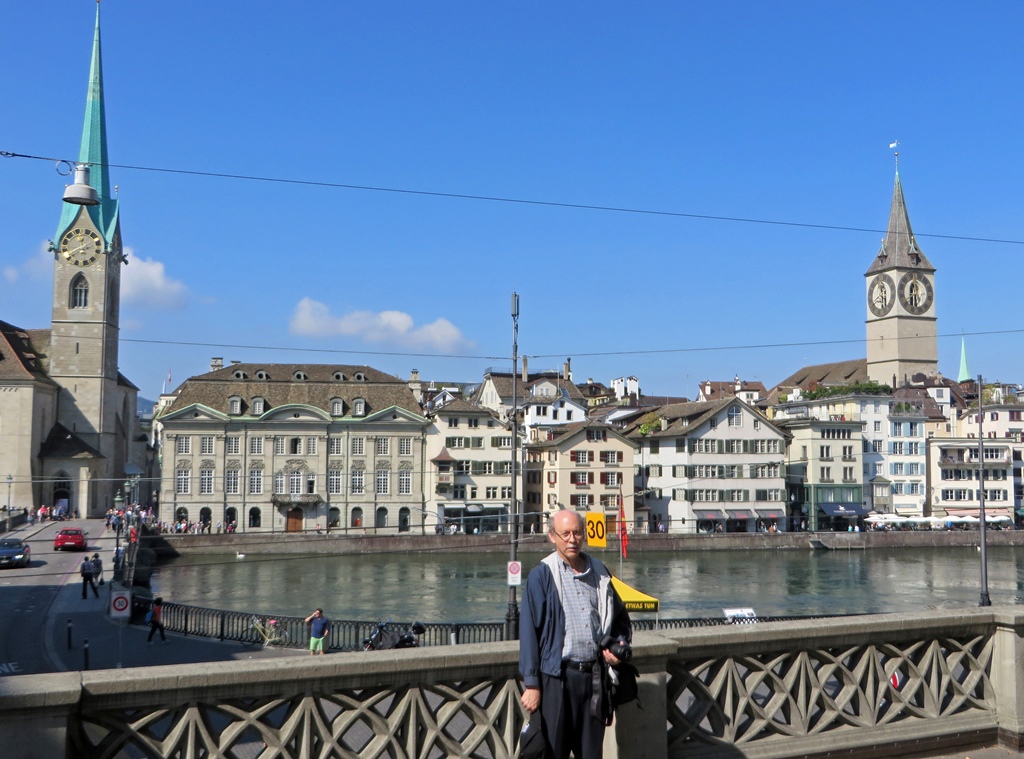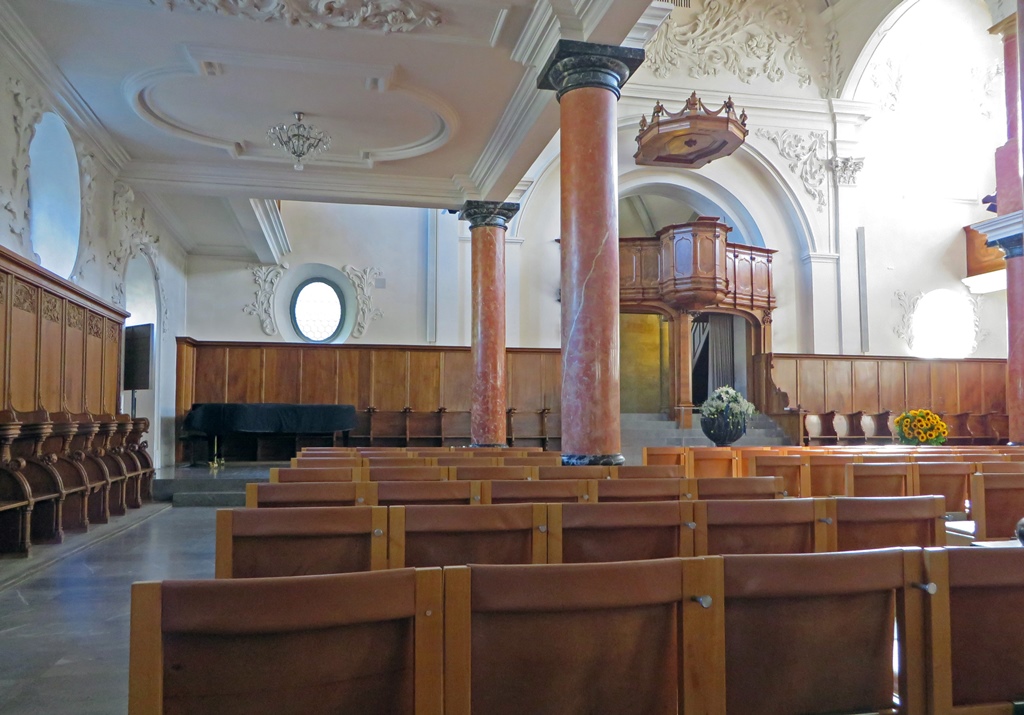Getting from Vienna to Zürich involves either a long, expensive train ride, or
a short, usually more expensive hop over on an airplane. But we found a special
deal, through the airline Germanwings, that would cost well under the price of
the train ride, and would not require that we sit on a train for several hours.
There were a couple of "catches" to this deal, however. First, we wouldn't be
able to leave Vienna until mid-afternoon, and second, the deal included a
layover in Cologne, Germany. Yes, the Cologne up next to Belgium. Another catch,
which we didn't know about, was that one of the Germanwings co-pilots had a
history of suicidal tendencies, and would later, in March of 2015, fly his plane
into a mountainside, killing himself and the other 149 people on the plane. I
don't know if this pilot had anything to do with either of our flights, but if he
did, he fortunately had a comparatively good day.
Getting from Vienna to its airport, which is 12 miles from the city center, can
be accomplished in a number of ways, none of which involve mountainsides. We
went for the cheapest method, the S-7 suburban train, which gets to the airport
in 24 minutes. There is another train, called the CAT train, which is heavily
promoted and undoubtedly nicer, but which costs more than double the S-7 rate and
takes 16 minutes to get to the airport. The taxi rate is three times the CAT
rate, but of course pays for everyone in the cab. Our flight to Cologne took 90
minutes and the flight to Zürich another 65 minutes, with the layover adding
another 100 minutes, putting us into Zürich around sunset. We found some dinner
at the airport and caught a train into town and walked the rest of the way to our
hotel, which was a short distance from the train station.
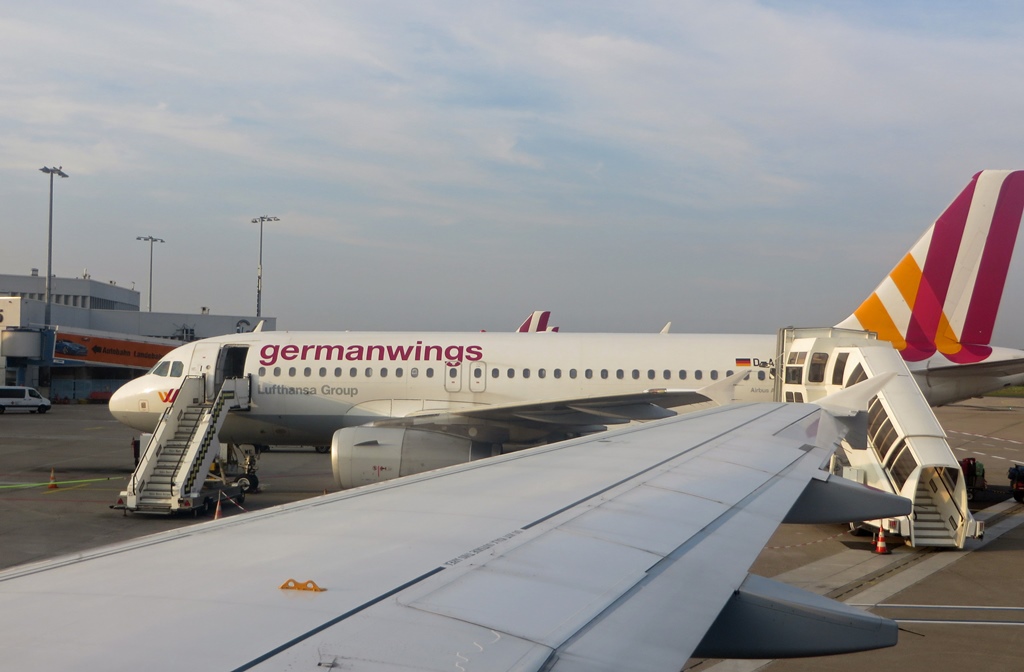
Germanwings Plane
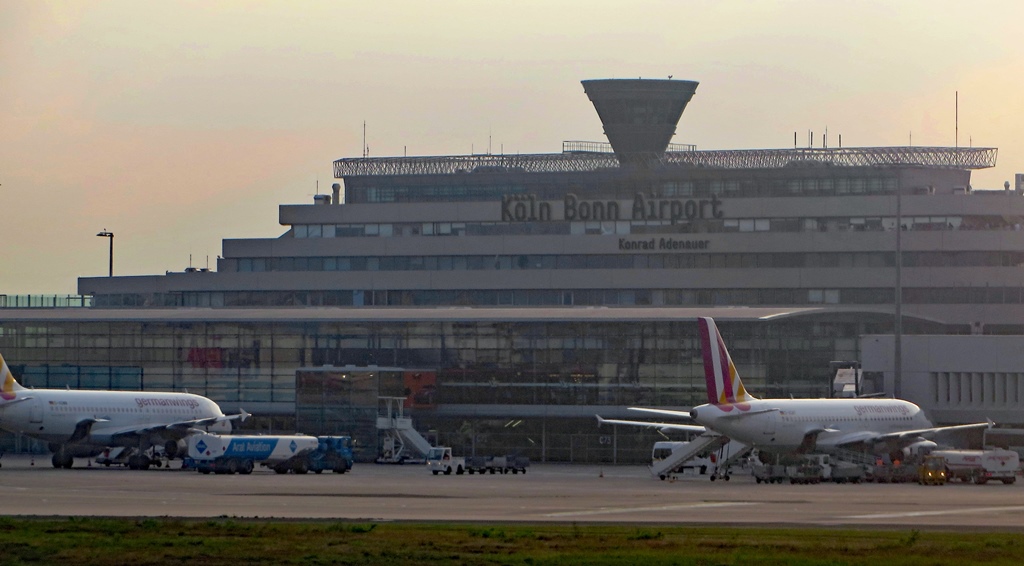
Terminal Building, Cologne Airport
Concourse, Cologne Airport
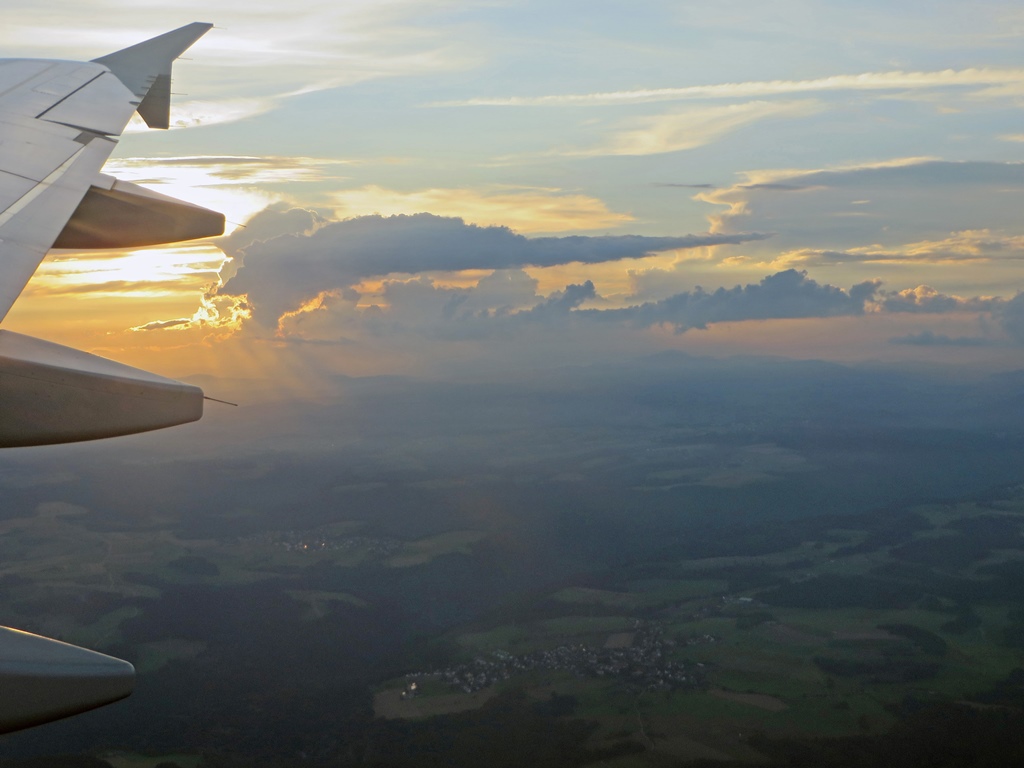
Swiss Countryside
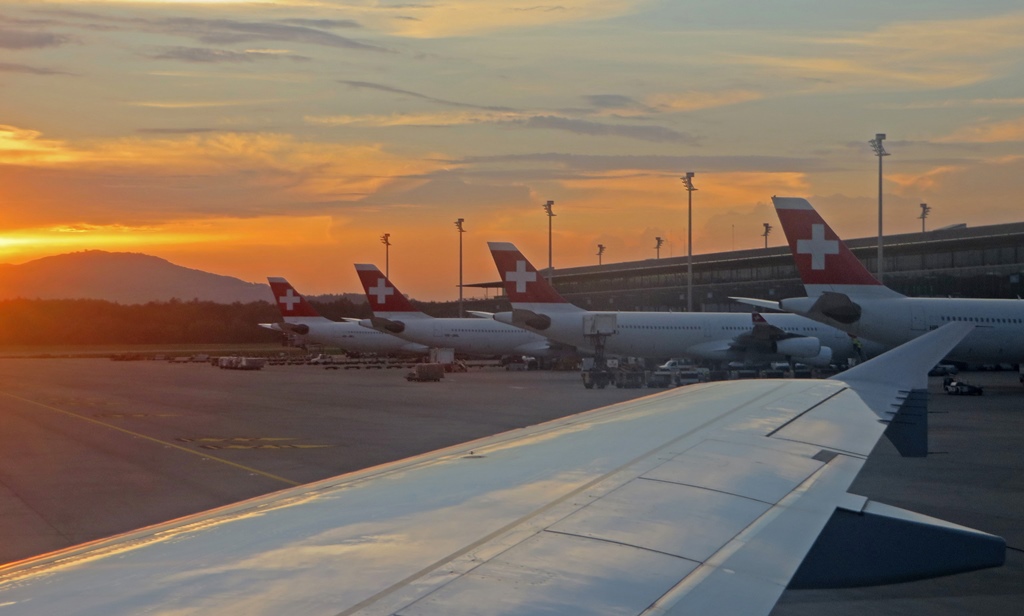
Sunset, Zürich Airport
Zürich is the largest city in Switzerland, with more than 400,000 people. It is
not the capital of the country, however – this honor goes to the city of Bern,
which is about one-third as big. Zürich is located at the north end of a long,
narrow lake known locally as the Zürichsee. The city is divided by the river
Limmat, which flows from the Zürichsee at its north end, heading northwestward to
eventually join the Aare River and ultimately the Rhine. Zürich is a major
transportation hub, with an airport and a railway station which are each the
largest in the country. Zürich is also one of the world’s largest financial
centers – most of the large Swiss banks, legendary for protectiveness of their
international clients, are located in the city. The language generally spoken in
Zürich is known as Zürich German, which is somewhat different from German German,
as is Swiss Standard German, which is one of the country's official languages
(the others are French, Italian and Romansch). On coins and stamps, the name of
the country appears in none of these languages, but rather as the word
"Helvetia", which comes from Helvetii, a Latin word referring to a Gallic
tribe that occupied most of the Swiss plateau prior to the Roman conquest. If this
all sounds potentially confusing, it is, potentially. Fortunately, Switzerland
is nothing if not a country of commerce, and the international language of
commerce is English, which is widely spoken. Switzerland's dedication to
commerce does not extend to sharing currencies with any other country.
Switzerland uses the Swiss Franc, which was worth about $1.11 in U.S. money
during our visit. In a way, this is consistent with Switzerland's policy of
military neutrality, which has been maintained since the Congress of Vienna in
1815 (convened to straighten out a number of issues that existed at the end of
the Napoleonic Wars).
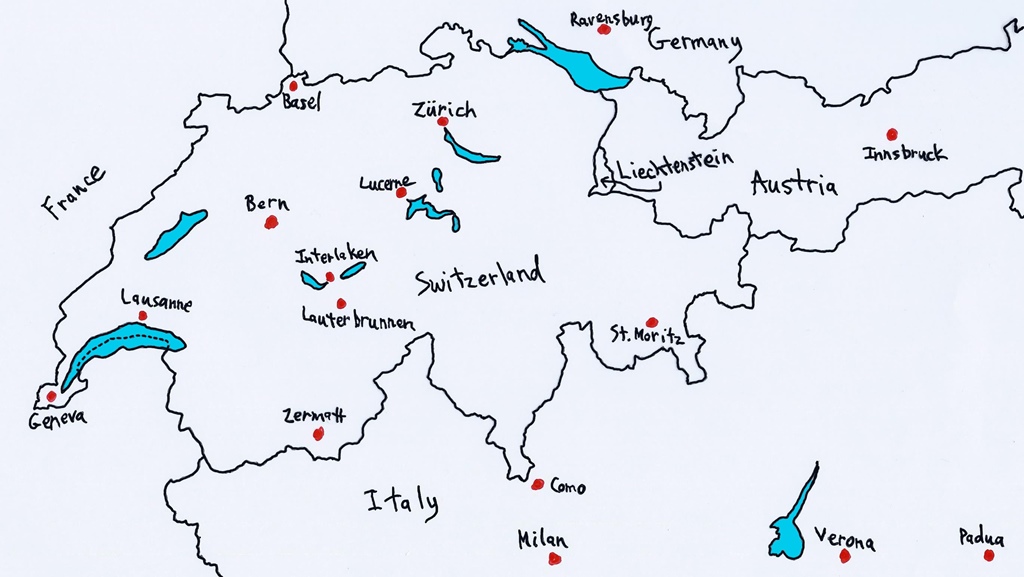
Switzerland
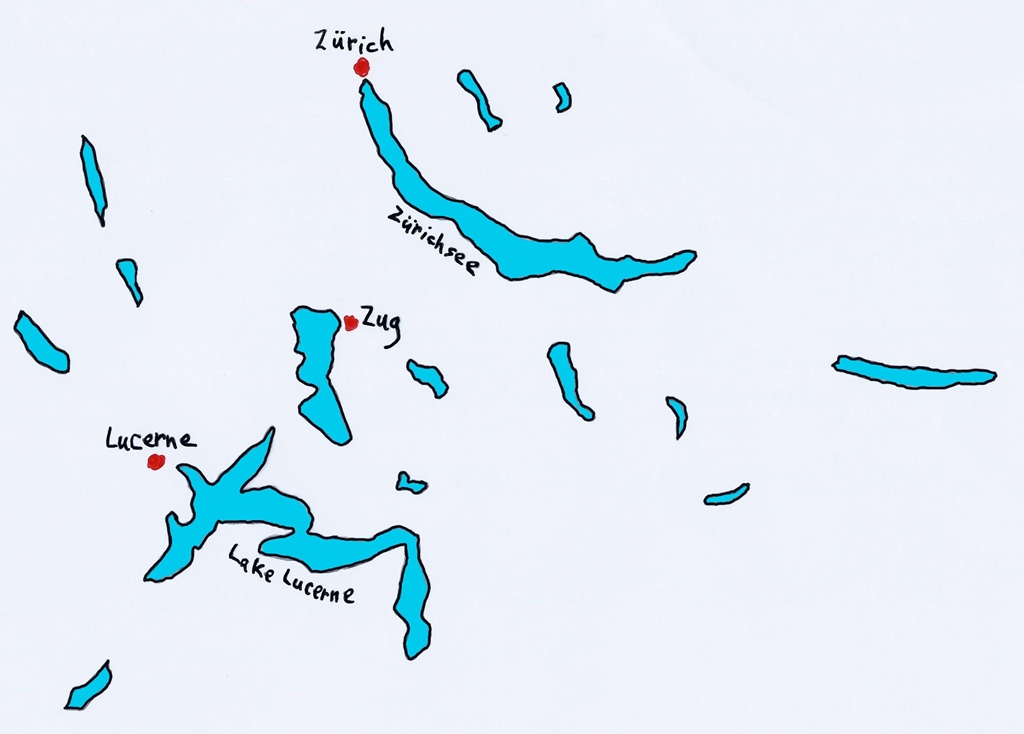
Zürich Vicinity
During the World Wars, neutrality was sometimes difficult to maintain, due to
conflicting pressures both internal and external. During World War II in
particular, the country was completely surrounded by Axis countries or countries
which had been occupied by Axis powers. Nazi Germany had in fact prepared a
plan (called Operation Tannenbaum) for the invasion of Switzerland, to be
followed by a division of the country between Germany and Italy. The plan was
never executed, possibly because there are some useful things (e.g. the stashing
away of ill-gotten riches) about having a neutral country nearby. The Allies
also found the neutral island in the middle of Europe to be useful at times.
Occasionally, Allied pilots of failing airplanes would head for the Swiss
border, before bringing their planes down. The pilots and crew would be imprisoned
by the Swiss for violating their airspace, but the airmen undoubtedly thought
that the Swiss accommodations and treatment would be far preferable to life in a
German POW camp.
Today, Zürich is considered to be one of the most livable cities in the world.
During our short visit, we found the city to be quite pleasant, though
expensive. The following is a menu from a restaurant that served ramen. Keep
in mind that while the restaurant's offerings were certainly better than the
packaged bricks consumed en masse by starving college students, they were
not exactly haute cuisine. Also keep in mind the exchange rate, which
was about $1.11 per Swiss Franc.
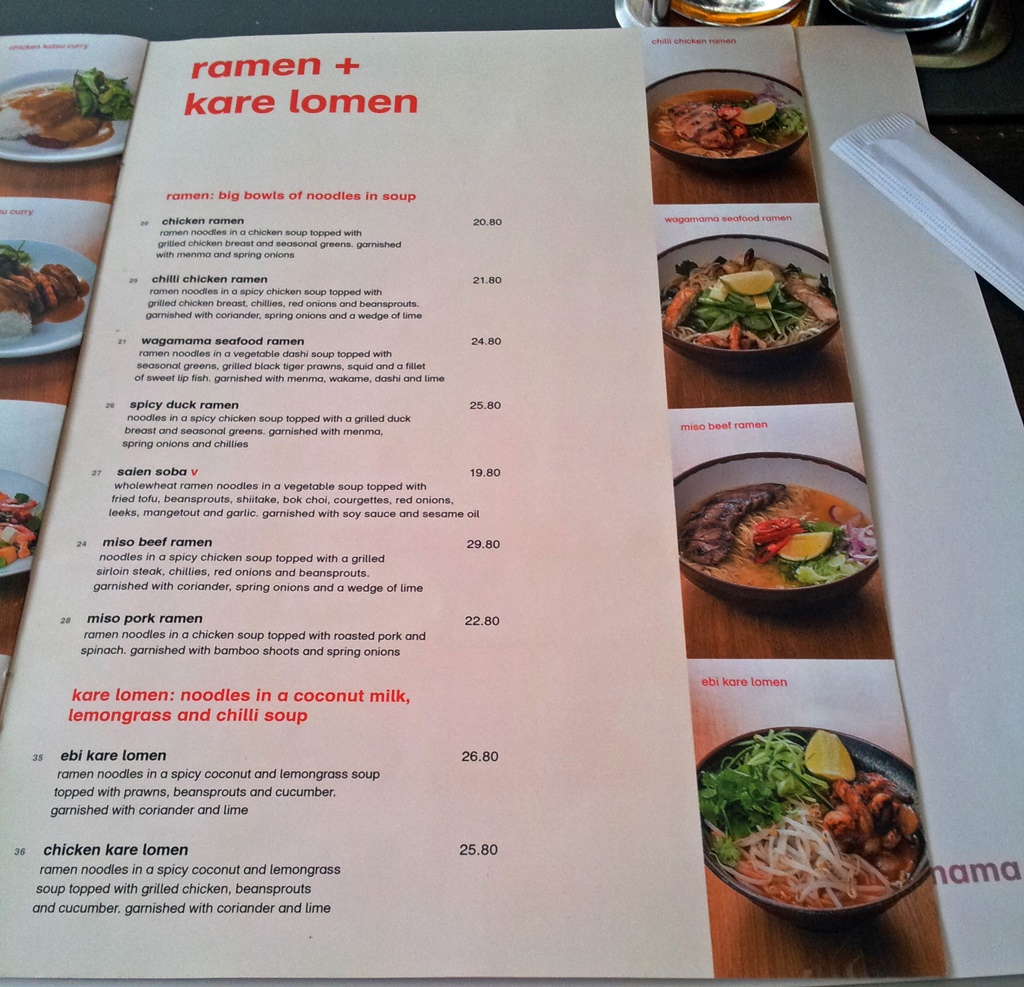
Expensive Ramen at Wagamama
The morning after our arrival, we emerged from our hotel, the Hotel Seidenhof,
with the intention of exploring Zürich's Old Town area. The main public transit
in the area seems to be the modern trams that run up and down the main street,
called Bahnhofstrasse, which extends from the train station at its north
end to the Zürichsee at the south end.
Hotel Seidenhof
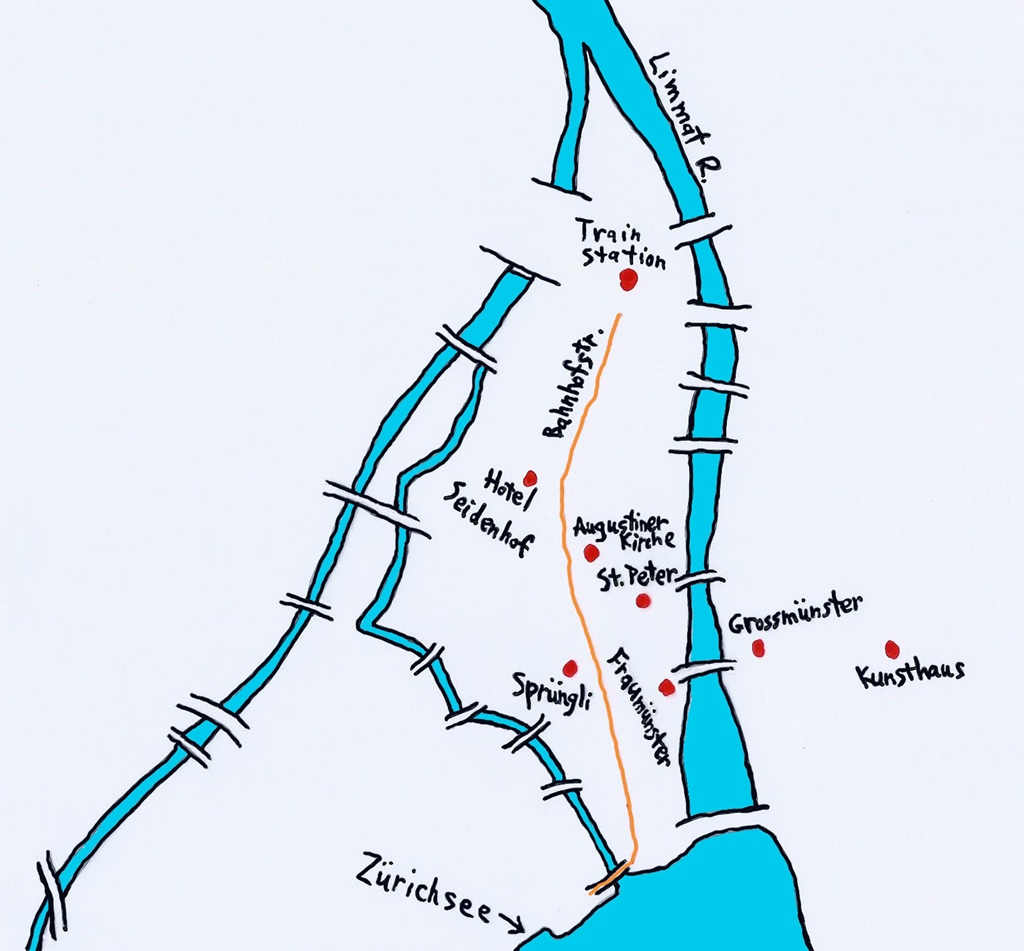
Zürich Old Town
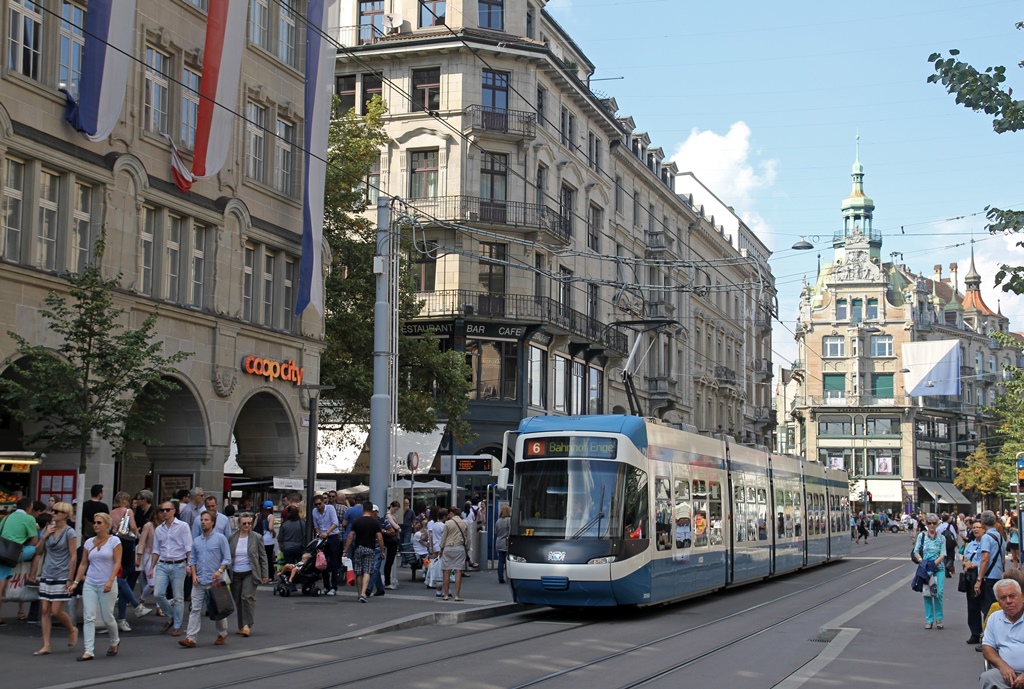
Tram on Bahnhofstrasse
We did not use the trams, however, as everything seemed to be in pretty easy
walking distance. We walked over to the Bahnhofstrasse and headed south. There
was a lot of classy-looking shopping to be seen on Bahnhofstrasse (mostly out of
our budget), including establishments selling justly-famous Swiss chocolate.
Kirche St. Peter Tower from Rennweg
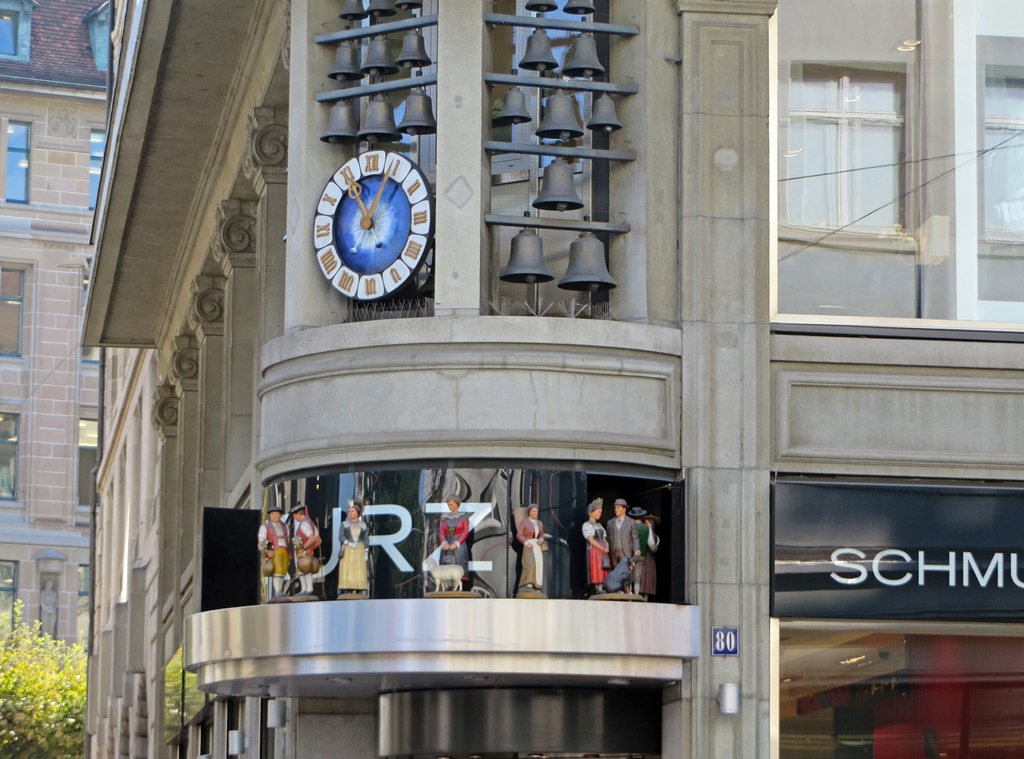
KURZ Schmuck Watch Store
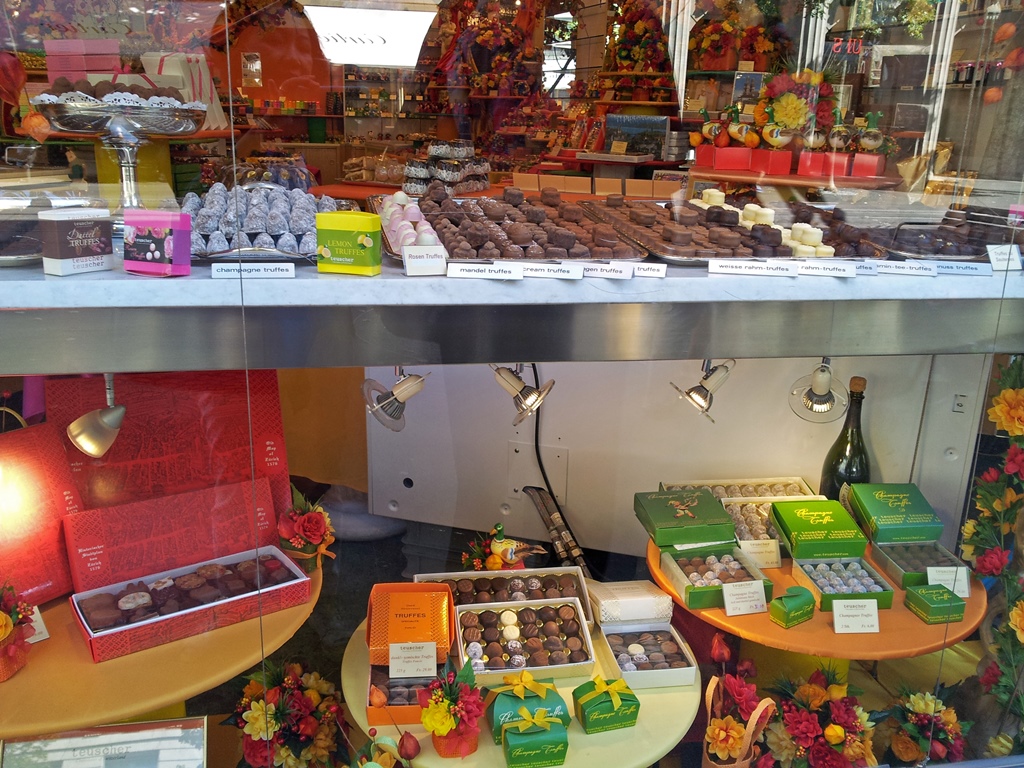
Window Display, Teuscher Chocolates
In our preparations for the trip, it seemed to us that Zürich was not big on major
tourist attractions, and this was pretty much borne out by our admittedly limited
explorations. However, the livability of the city may actually be enhanced by the
fact that large groups of tourists are generally on their way to somewhere else
and don't stay long. We found the main attraction of the city to be the city
itself, which is a nice place to be, rather than any particular landmarks. But
there are some things to see, and we made a determined effort to see them in the
short time we were to have in the city.
The first tourist sight we came across was a church called the Fraumünster,
on the west bank of the Limmat. The Fraumünster is a nice-looking church with a
tall, pointy clock tower. It's a Protestant church (Swiss Reformed), so it
doesn't have a huge amount of interior decoration. It does, however, have a
series of five stained glass windows designed by the artist Marc Chagall.
Photography was not permitted. The church has an interesting history. It's
built on the site of an abbey for aristocratic women that was established in 853.
In 1045 the abbey was given exclusive rights by Holy Roman Emperor Henry III
(holding markets, collecting tolls, etc.) that essentially made its abbess the
ruler of the city. In the 14th Century, the abbey's power waned as the city's
guilds gained more say in the city's dealings. The abbey itself was dissolved in
1524 as part of the Swiss Reformation. The abbey buildings managed to survive
for a while, though, not being demolished (and replaced by a building for use by
the city) until 1898. The church itself has survived, however. Though very
much different from its original version, it seems to be a result of many
incremental renovations, rather than any complete rebuilds. The last major
renovation took place in 1911-12. A square across from the church called the
Münsterhof, once the main square and marketplace of the medieval city,
also survives.
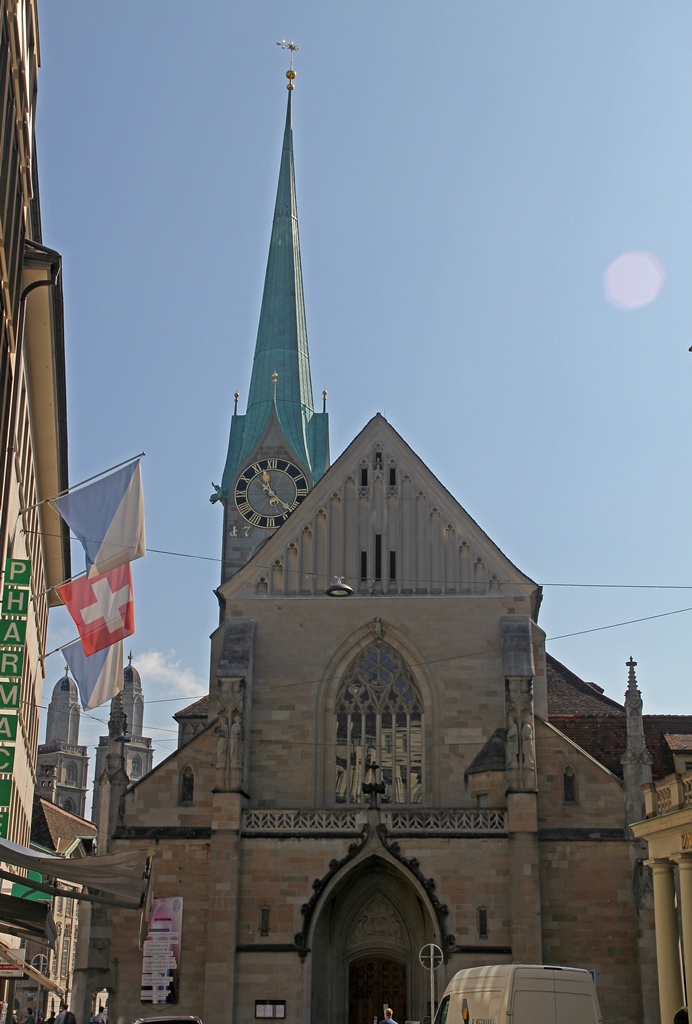
Fraumünster Church
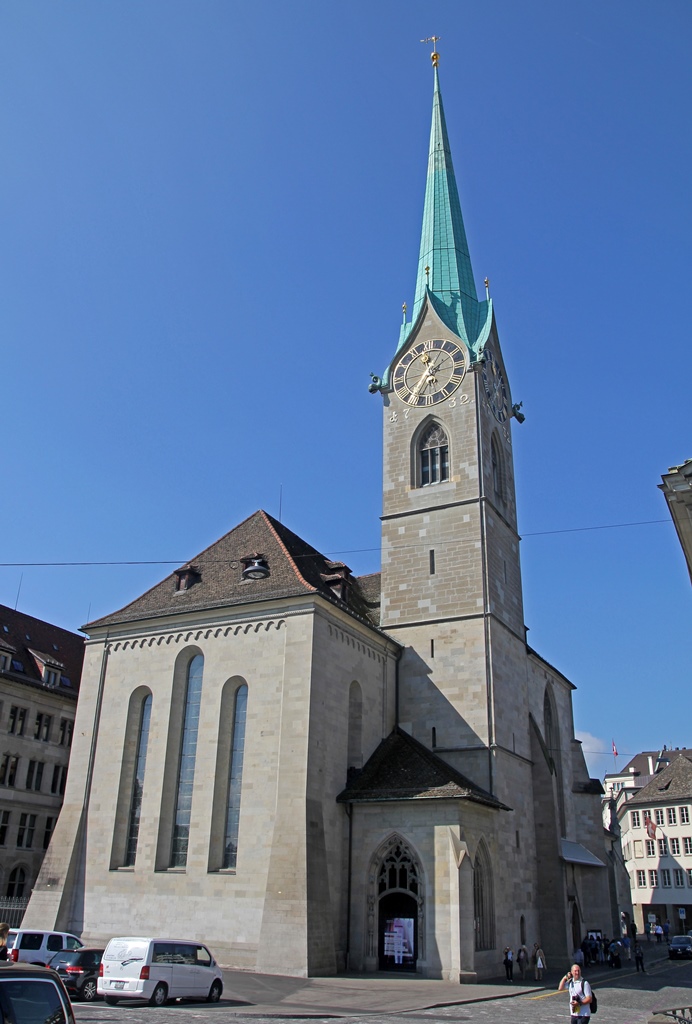
Fraumünster Church
Münsterhof
A bridge called the Münsterbrücke crosses the Limmat River near the
Fraumünster. There are some nice views from the Münsterbrücke.
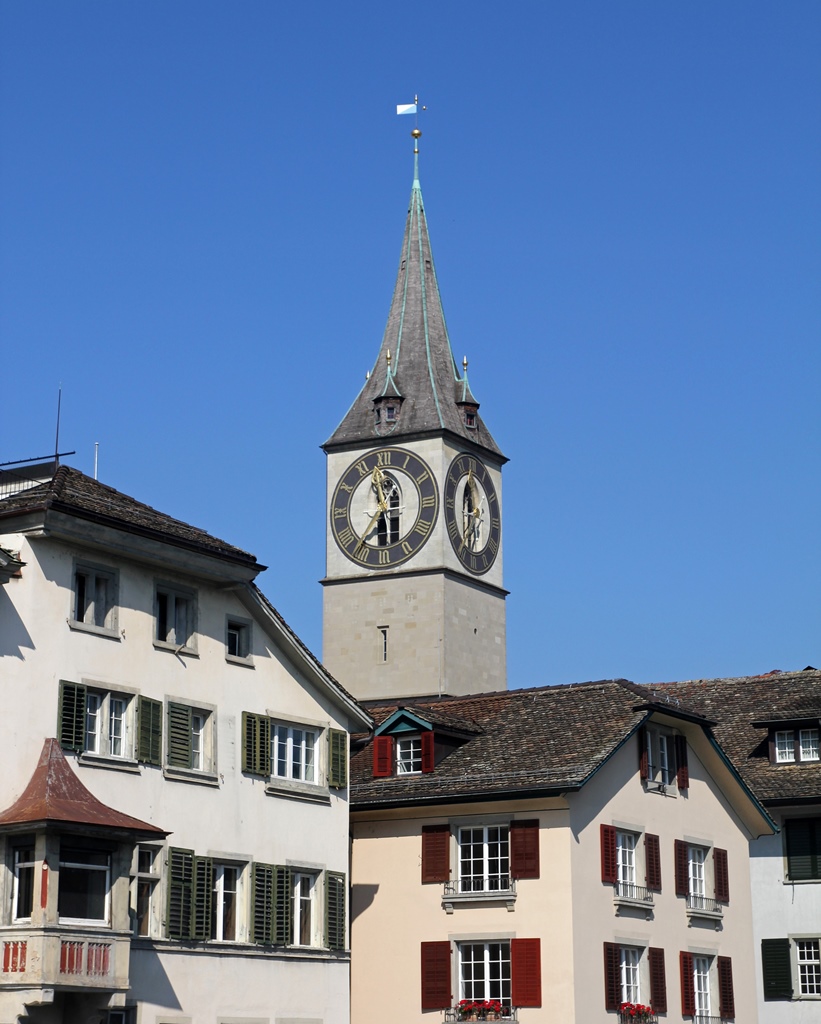
Kirche St. Peter Tower
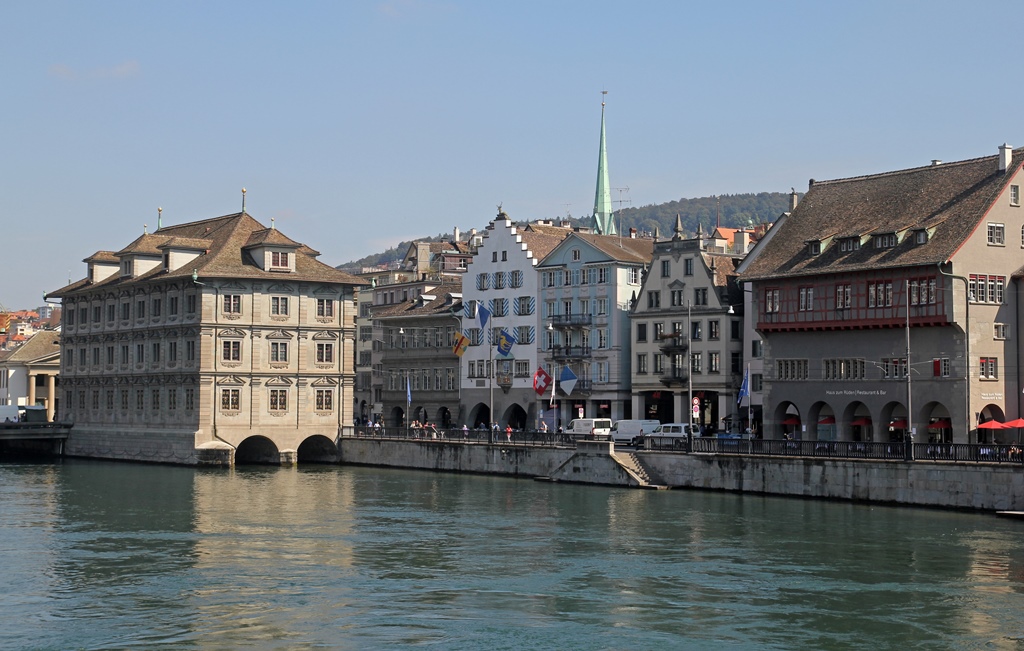
Rathaus and Buildings Along Limmat River
Bob with Fraumünster, Kirche St. Peter and Limmat River
Across the river from the Fraumünster is another historical old church, this one
called the Grossmünster. Not too much thought seems to have gone into
this name, as it means "big church". This name was probably given to distinguish
the church from the Fraumünster across the river (which is smaller). With two
churches so close together, one might expect a rivalry to have existed between
them, and one would be correct in this expectation. In another time, this might
have taken the form of intense football games, but in the pre-Reformation days,
this rivalry expressed itself as contention for possession of the relics of the
patron saints of Zürich, Saints Felix and Regula. Felix and Regula were members
of a Roman legion which converted to Christianity in the year 286. This wasn't
allowed, so the entire legion was sentenced to be executed. Felix and Regula
didn't want to be executed, so they ran off. They were pursued and eventually
caught in the settlement (called Turicum) that would later become Zürich,
and they were executed by decapitation. According to legend, their decapitated
bodies, apparently unhappy with the surroundings, picked up their own heads,
walked forty paces uphill and prayed before properly dying. They were buried on
this spot. On the spot that would one day become the Grossmünster. According
to another legend, in the 8th Century, Charlemagne was passing through when his
horse apparently had a vision, and dropped to its knees to pay tribute to the
burial spot of Felix and Regula. Charlemagne directed that a church should be
built here, and it was. The present structure was built on this spot between
1100 and 1220 in Romanesque style. Several renovations took place over the
years, with the Grossmünster's iconic twin towers being added between 1487 and
1492. They originally had wooden steeples, but these were destroyed by fire in
1763 and were replaced by the present sandstone versions in 1787. To pay
tribute to Charlemagne, there is a statue of him part way up the south tower.
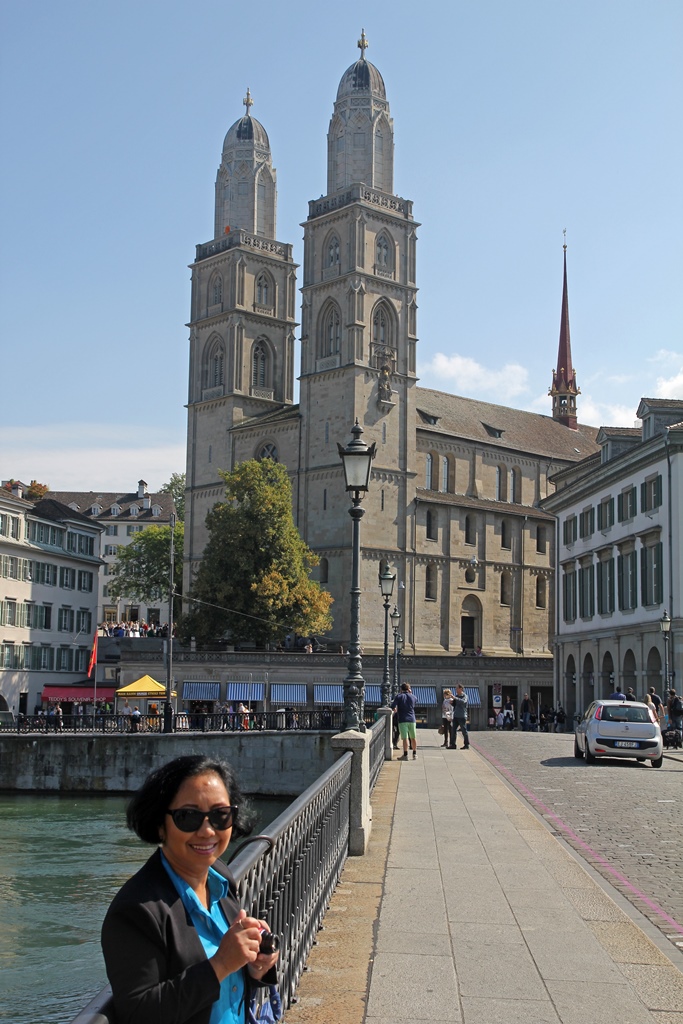
Nella and Grossmünster
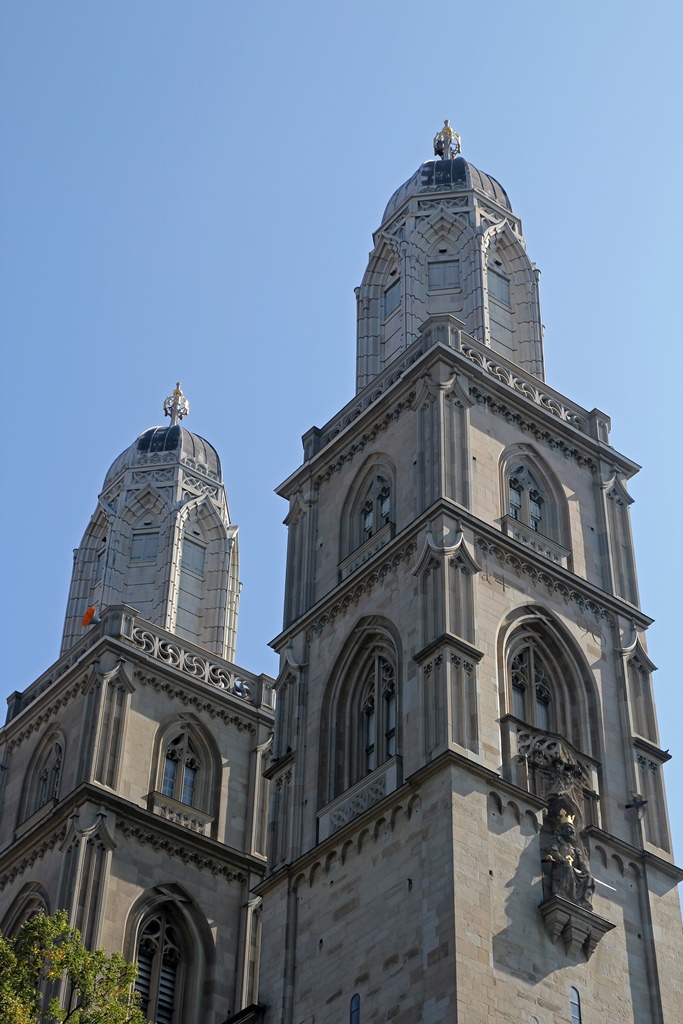
Grossmünster Towers
Another claim to fame of the Grossmünster is that it's generally considered to
be the origination point of the Swiss Reformation. In 1519 a man named Huldrych
Zwingli became pastor of the church, where he began preaching about ideas for
reform of the Catholic Church. The ideas started to gain popularity, but not
all of the Swiss people were on board. The Swiss were (and are) organized as a
confederation of semi-independent states known as cantons, and some of
the cantons became "reformed" cantons, while others stayed with traditional
Catholicism. This led to a division between the cantons, which still exists
today. Zwingli hoped to eliminate or at least minimize divisions within
Protestantism, so he was interested in reconciling his ideas about reformation
with those of Martin Luther. He actually met with Luther and several other
theologians in an event called the Marburg Colloquy in 1529. Several points of
agreement were reached, but the two Reformation factions could not agree on
their interpretation of the eucharist, so a split within Protestantism
remained, which has never been resolved. Returning to the split between the
Swiss cantons, discussions between the cantons led to disagreements over such
issues as the right of reformers to preach within Catholic cantons, and the
disagreements eventually led to armed conflict. One such conflict led to the
death of Zwingli, who was trying to be a soldier after joining a
hastily-assembled Zürich defensive force. Zwingli's successor, a man named
Heinrich Bullinger, continued his reforms, which included such things as
removal of religious statuary, prohibition of church music, and
discontinuation of celibacy among the clergy.
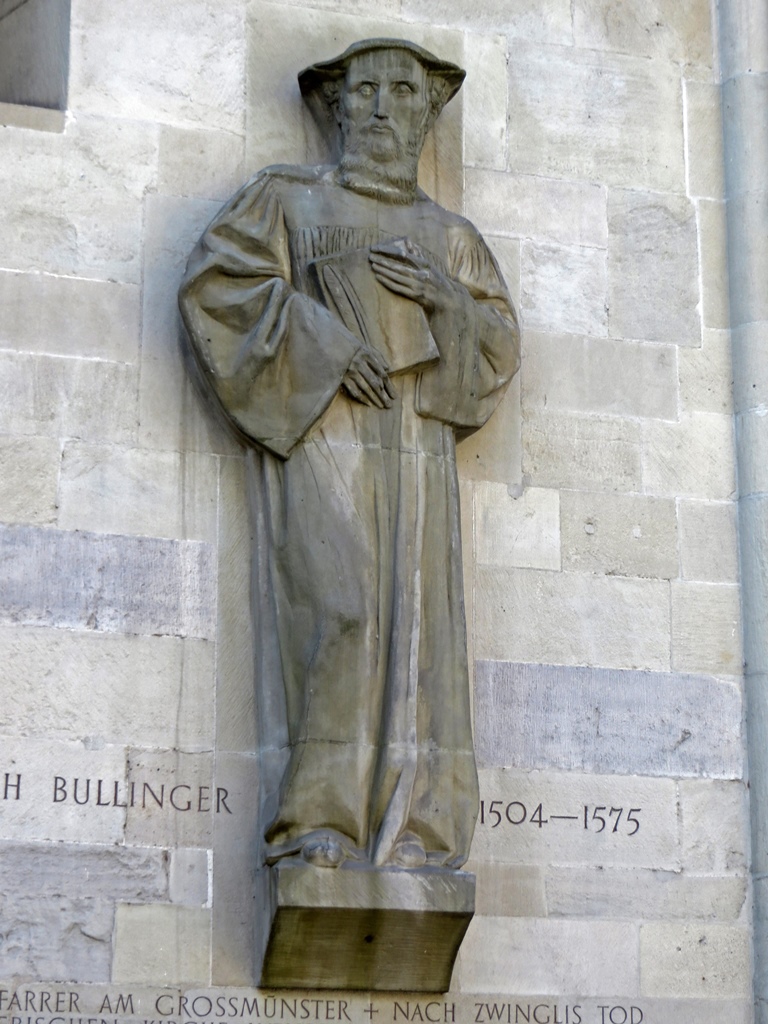
Statue of Heinrich Bullinger
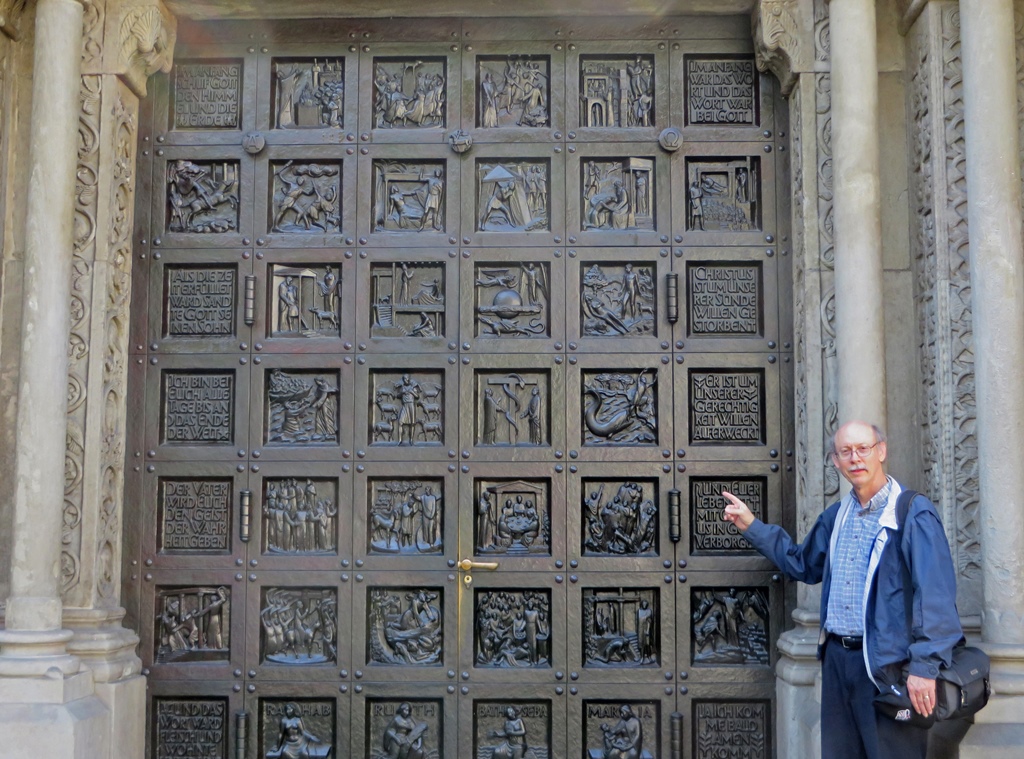
Bob and Church Door
We entered the Grossmünster to have a look around. One difference from the
Fraumünster became apparent – the Grossmünster was OK with photography.
Another difference was that visitors were allowed to climb one of the
towers (for a small fee) to take in the view of Zürich. Nella wasn't up for
this, but I climbed the 187 steps of the south tower (called the
Karlsturm) and enjoyed the view immensely.
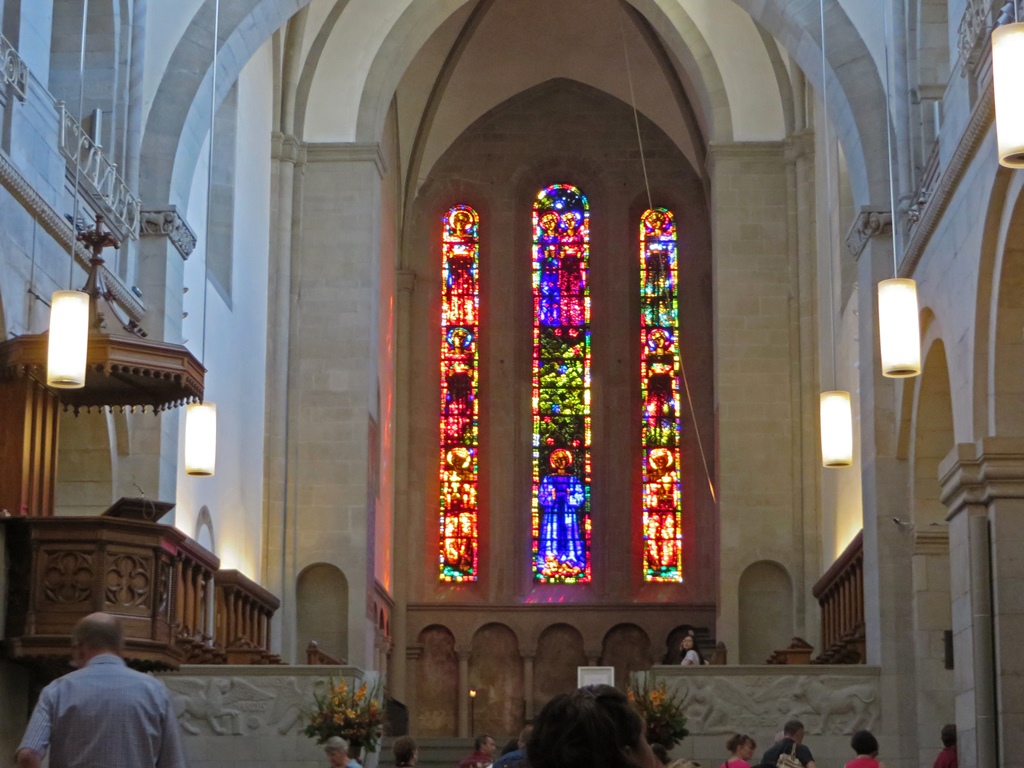
Stained Glass Windows, Augusto Giacometti (1932)
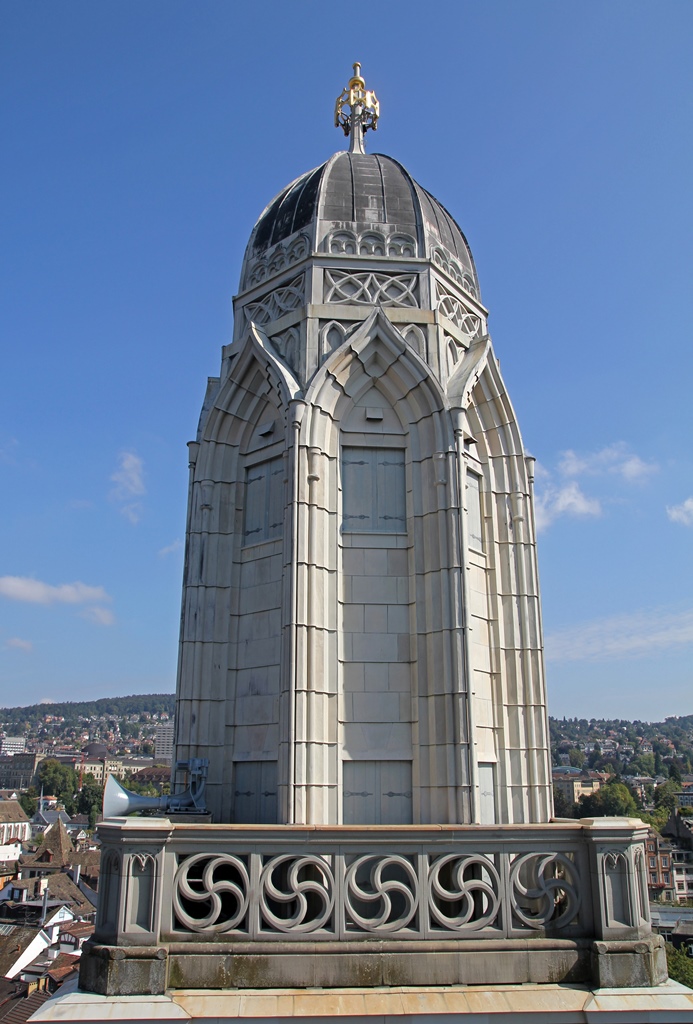
North Tower from South Tower
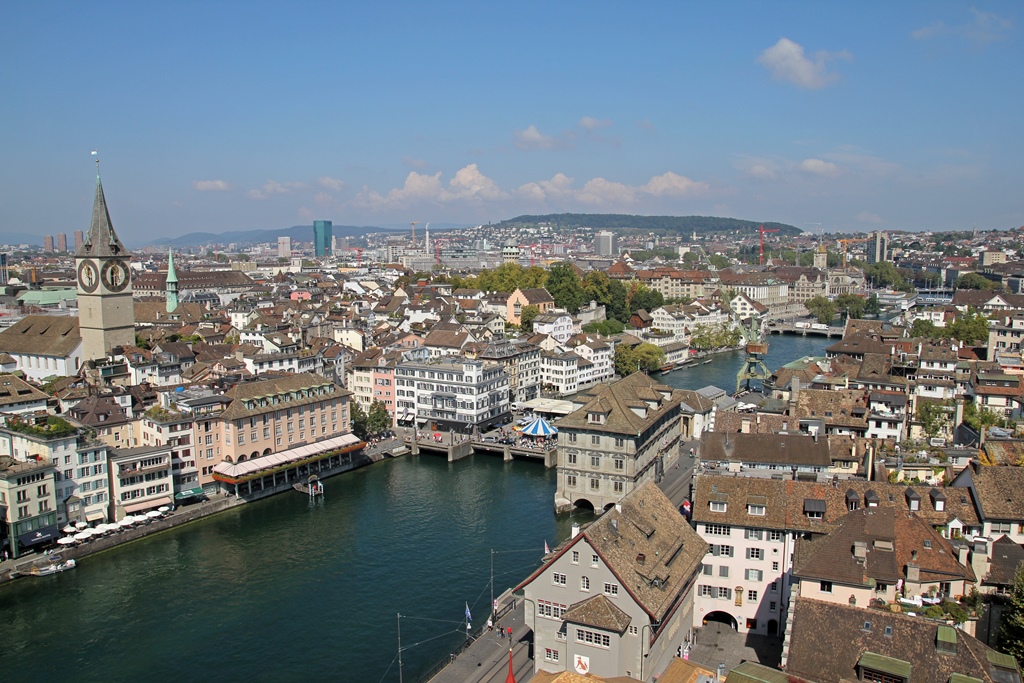
Limmat River, Kirche St. Peter and Rathausbrücke
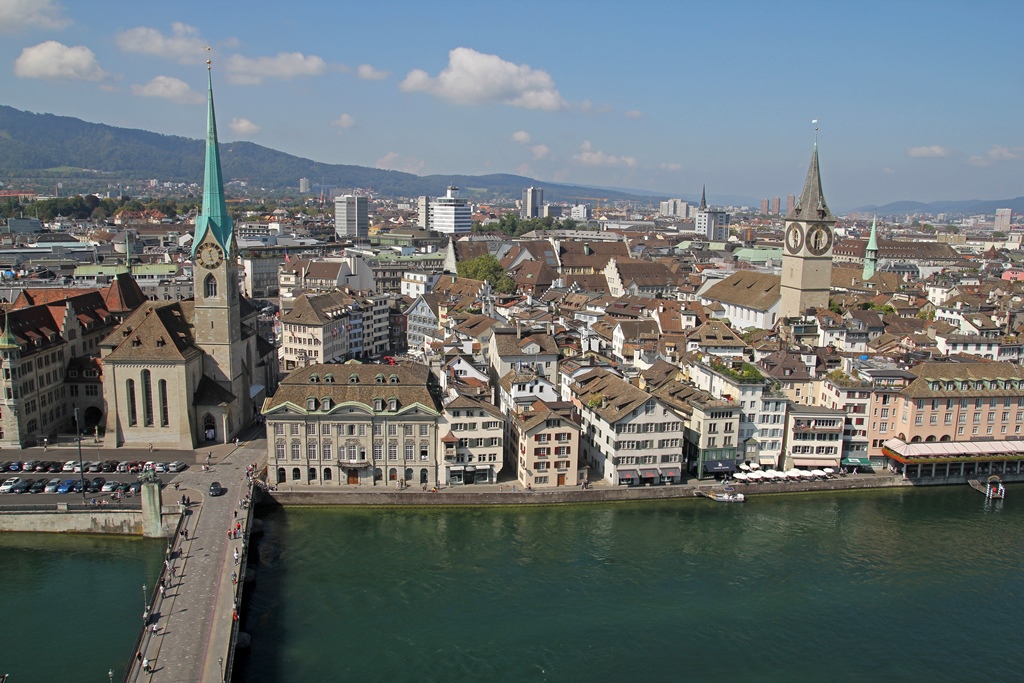
Fraumünster, Kirche St. Peter and Limmat River

Fraumünster, Rathausbrücke, Kirche St. Peter and Limmat River
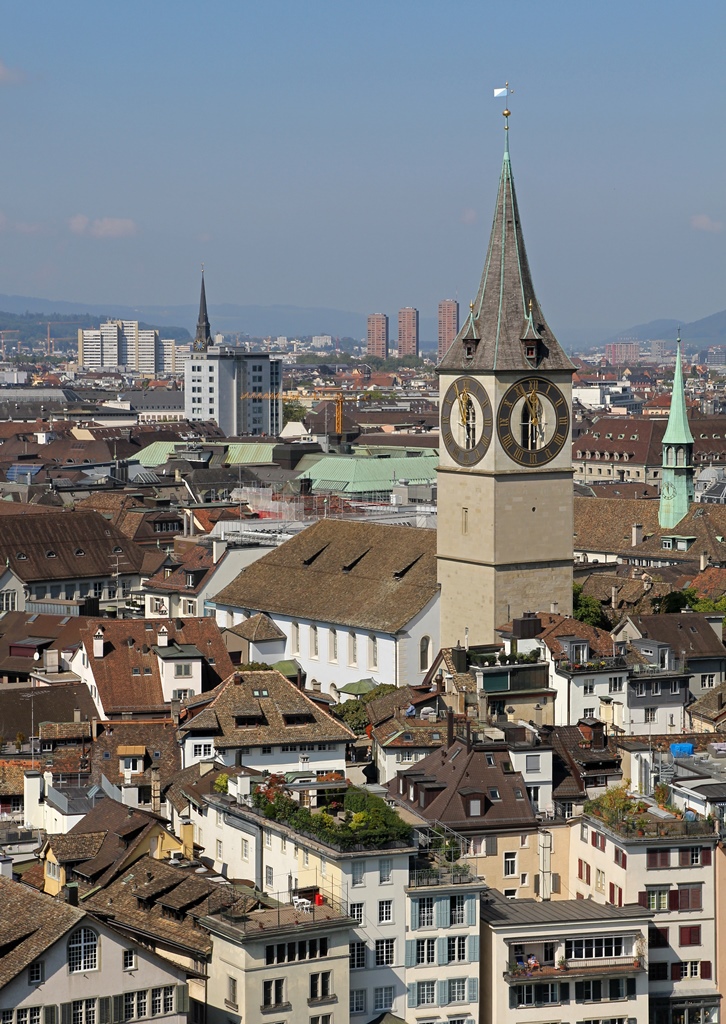
Kirche St. Peter
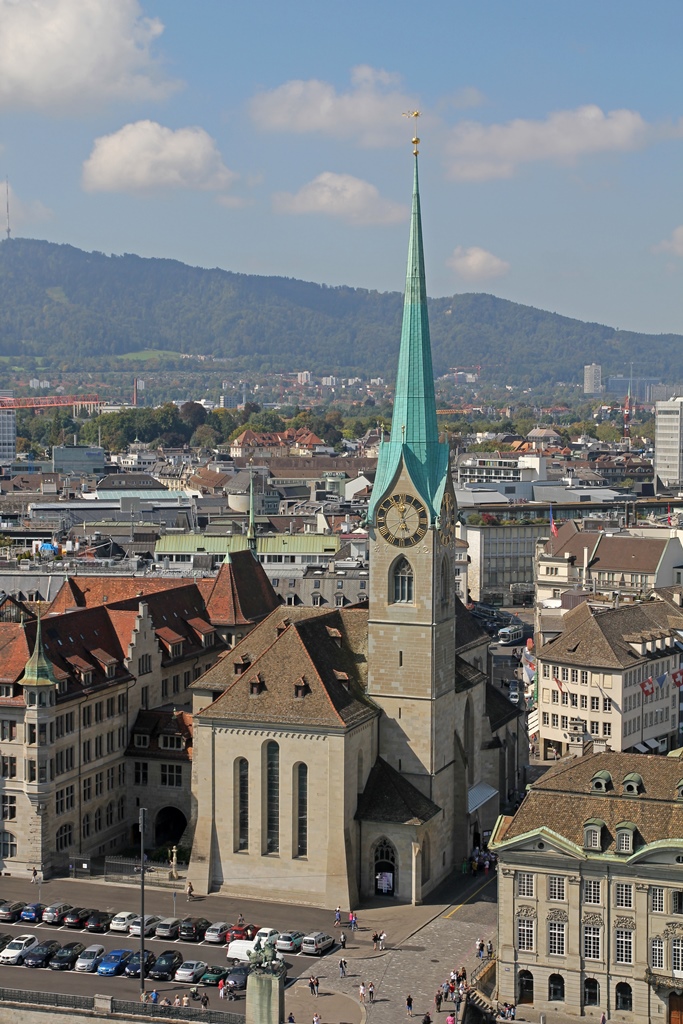
Fraumünster
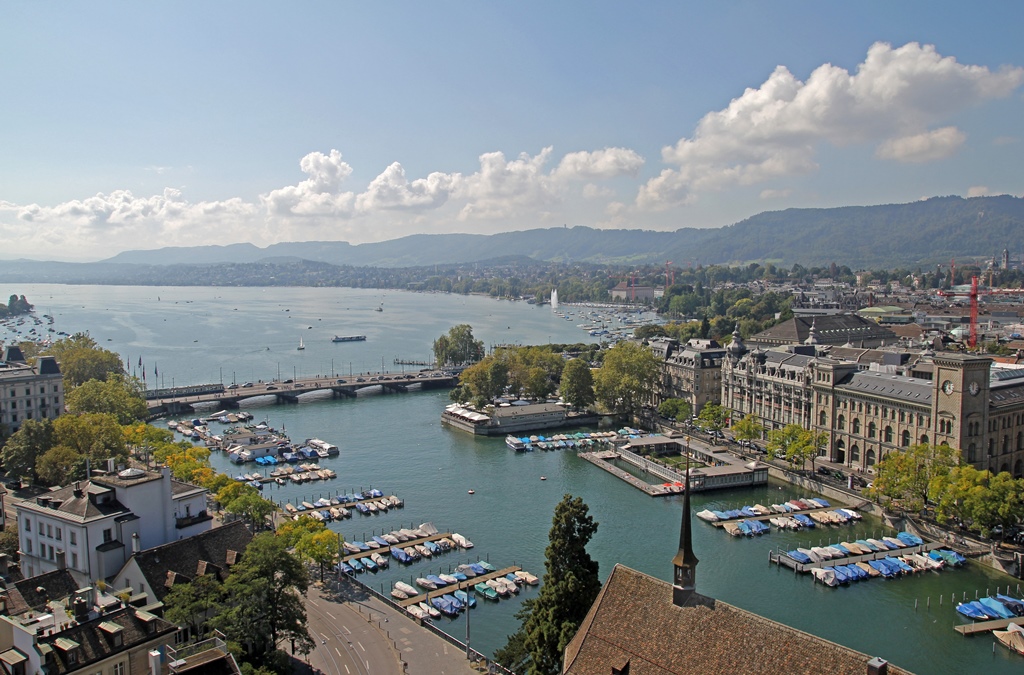
Limmat River and Zürichsee

Limmat River, Zürichsee and Steeple
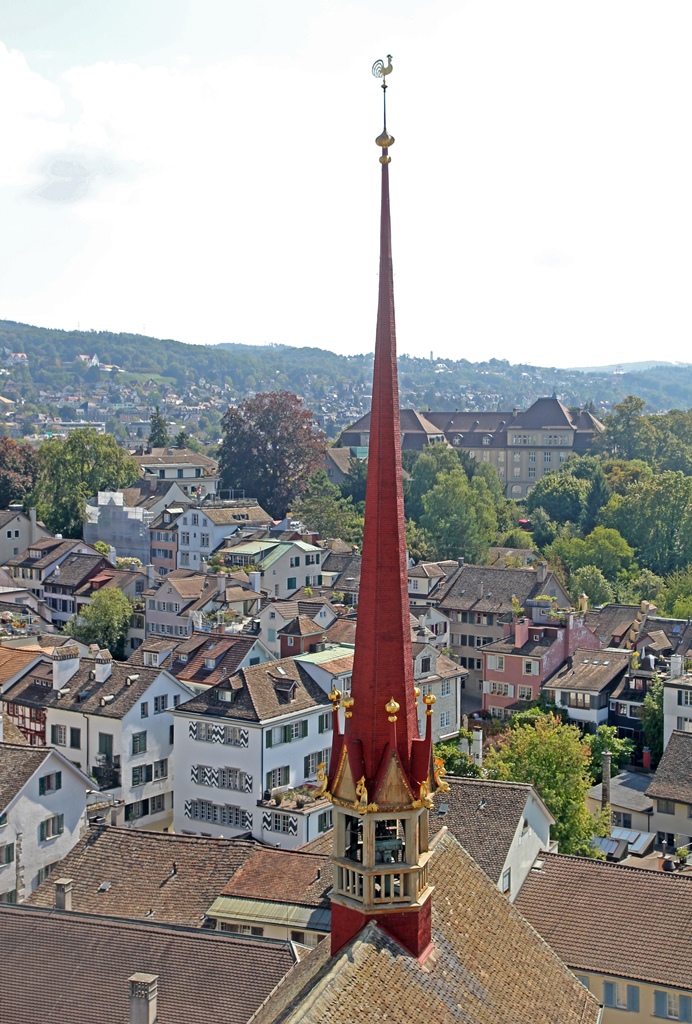
Church Steeple
After visiting the Grossmünster, we went looking for lunch, crossing back to
the west side of the river. We eventually found a Thai place that didn't quite
cost an arm and a leg (maybe just a forearm and a thigh), and across the road
from the restaurant we noticed a small Ladurée Shop. Those of you who've read
our Paris pages (the
Champs-Elysées page
in particular) might remember that
Ladurée is a Paris-based patisserie that makes some very wonderful (but
non-discount) pastries, with macarons being a specialty. We bought a small
bag of exotically-flavored macarons and consumed them back at the hotel later.
Regrettably, this shop closed in 2017, so if you're in Zürich and feel a need
for Ladurée macarons, you'll have to head over to northern Italy (there's a
shop in Milan) or to France (where there are several). On the other hand,
from walking around in Zürich, it will become clear to you that Ladurée does
not have a monopoly on macarons.
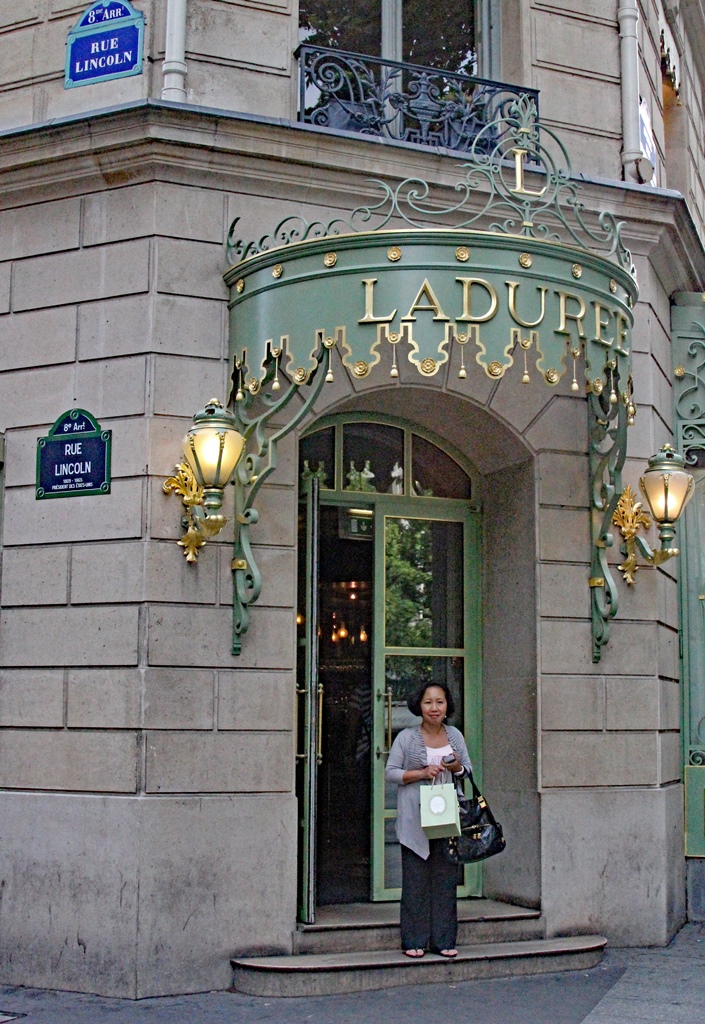
Nella at Paris Ladurée Shop, 2010
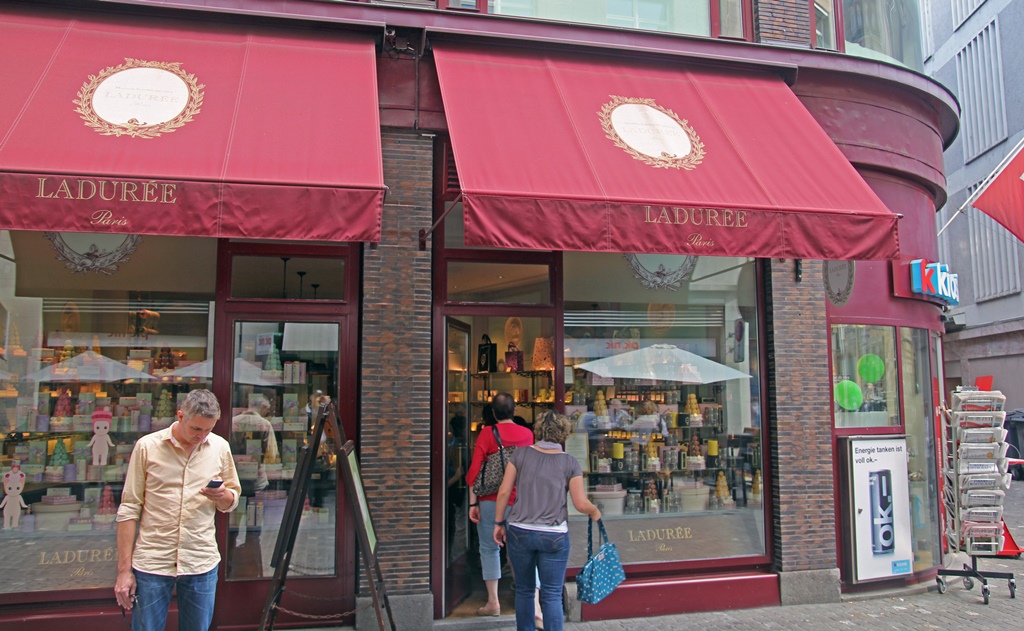
Ladurée Shop on Kuttelgasse (now closed)
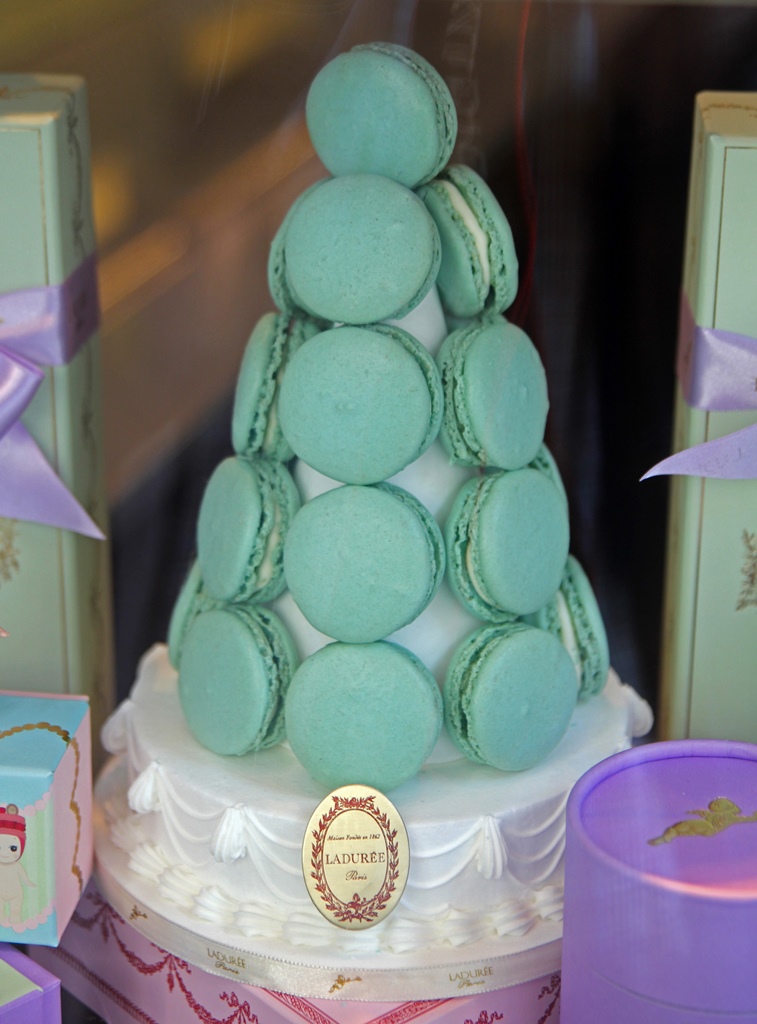
Green Macarons, Ladurée
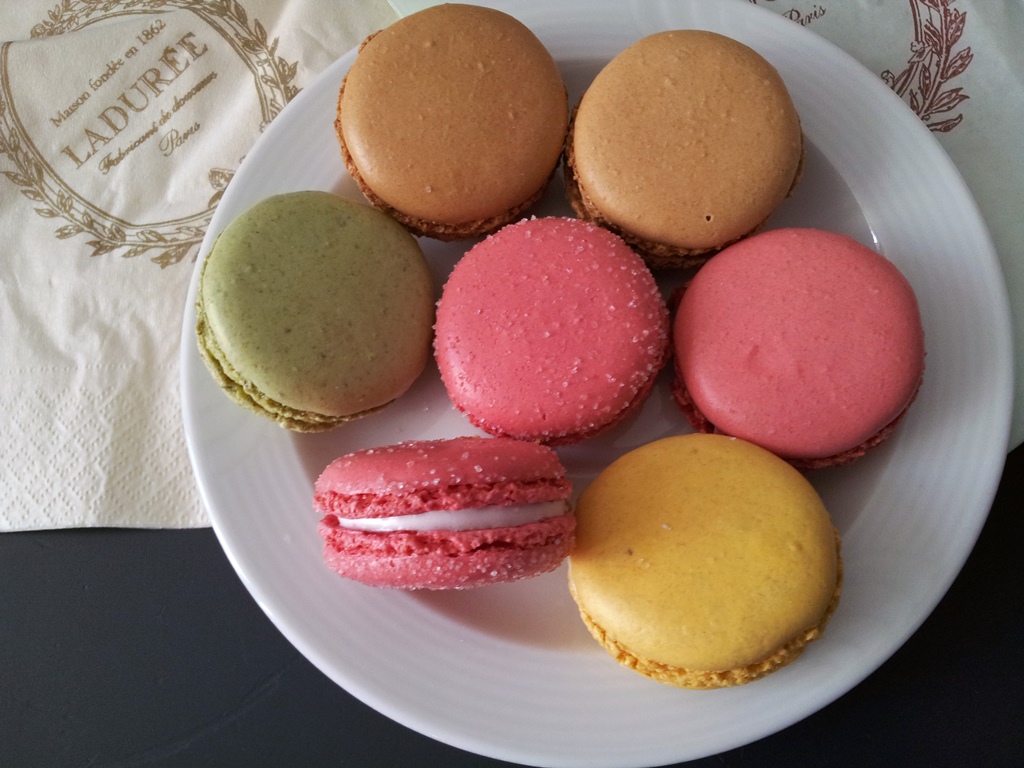
Macarons from Ladurée
We discovered this fact in the course of visiting the train station, of all
places. We had plans for the next day of taking a day trip from Zürich (gruesome
details to come, in a future page), and walked up the Bahnhofstrasse to the
station, where we bought the necessary tickets.
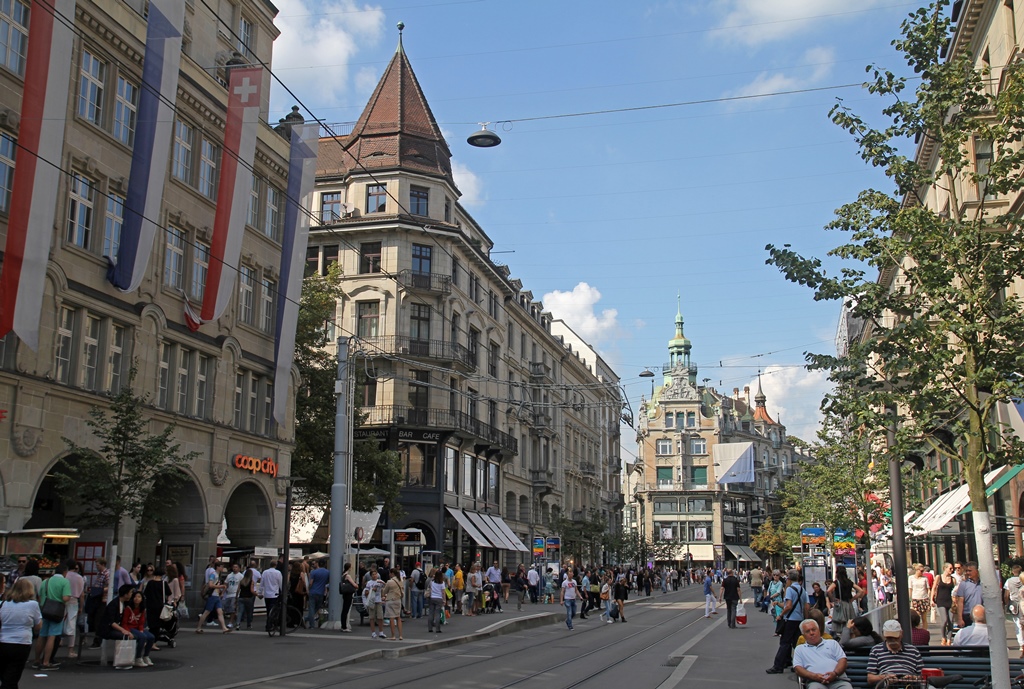
Bahnhofstrasse
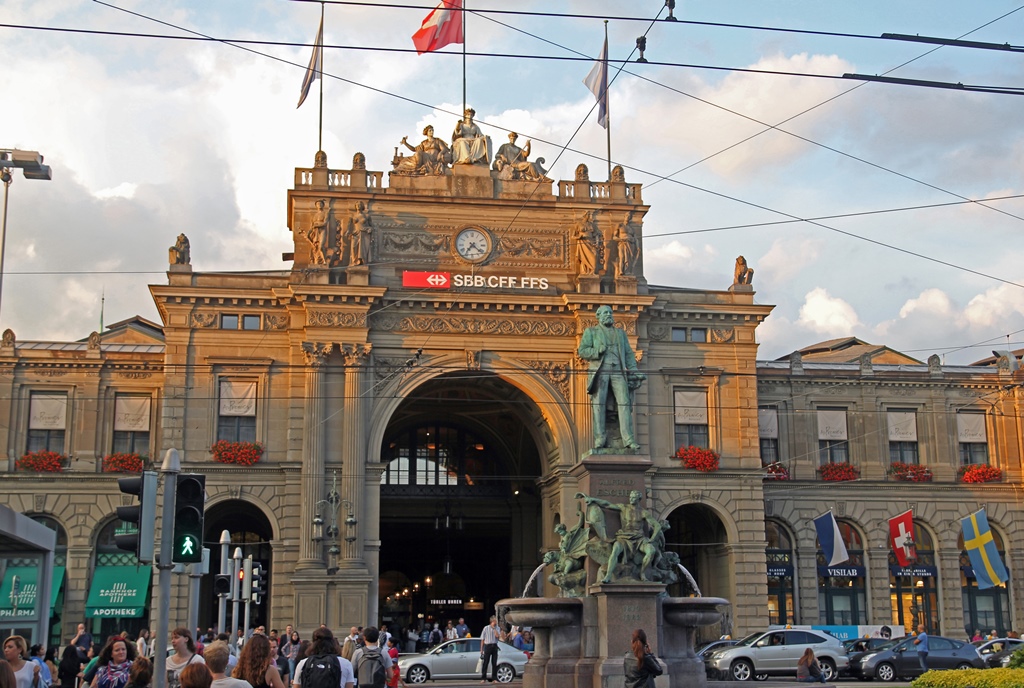
Train Station
Zürich's train station, as stated above, is the largest in Switzerland. It has 26
tracks which handle up to 3,000 trains and more than 400,000 passengers per day. To
serve the hordes of passengers, there is an underground shopping center called
"ShopVille" which has more than 200 shops. One of these stores is a Sprüngli store.
You may be aware of a company called Lindt & Sprüngli, which manufactures and sells
confections (mainly chocolate) throughout the world, mostly under the Lindt brand
name. The Sprüngli stores are not part of this company, though they were at one
time – they split into two companies in 1892. The company that runs the stores is
called Confiserie Sprüngli. The stores, nearly all in Switzerland, sell a variety
of pastries and confections, but their signature product is macarons, which are
sold under the brand name "Luxemburgerli". We visited the store but did not buy
any Luxemburgerli, as we already had a bagful of macarons from Ladurée. We did
split a pastry, however, which was excellent.
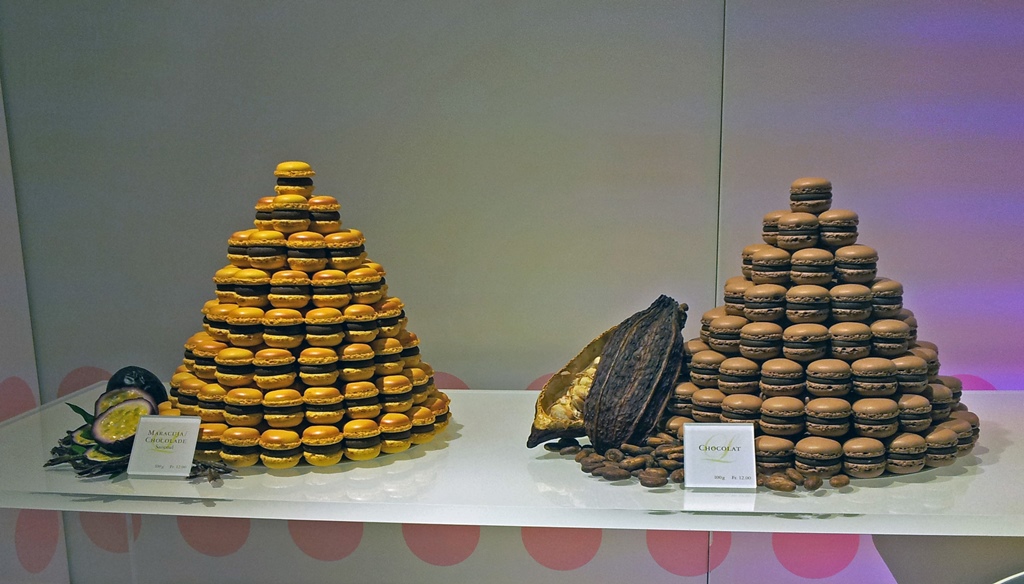
Macarons at Sprüngli Shop, Train Station
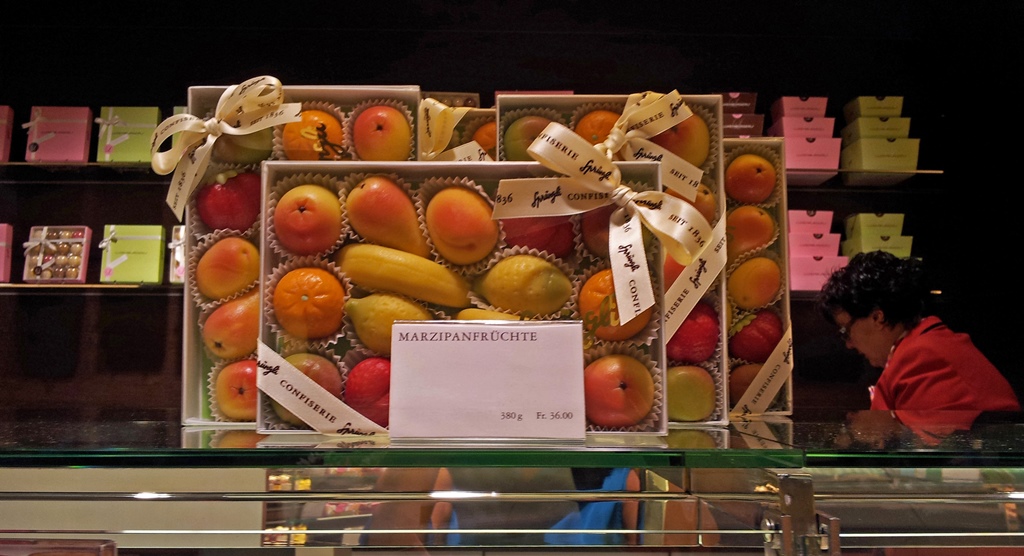
Marzipan Fruits at Sprüngli Shop
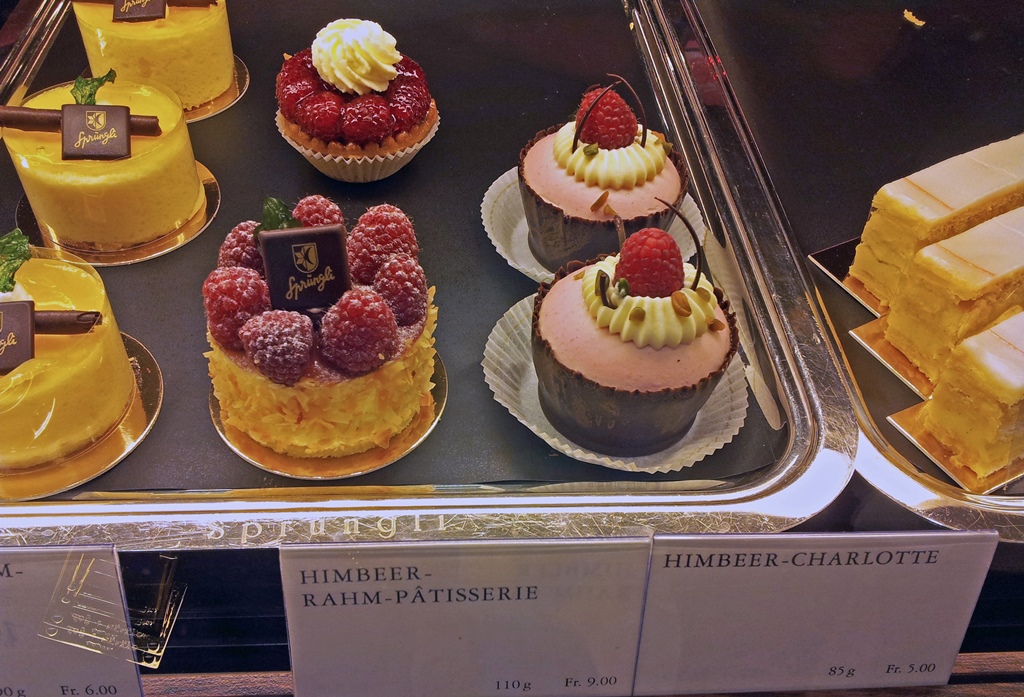
Pastries at Sprüngli Shop
From the train station, we returned into town to have a closer look at another
church we'd seen from the Grossmünster, the St. Peter Church. The St. Peter
Church is distinctive-looking because of the uncommonly large clock faces on
its tower. These clock faces are in fact the largest on any church in Europe,
with a diameter of 28.5 feet. St. Peter is another Reformed church. There
has been a church of some description on the site since the 8th or 9th Century
and several rebuilds since then. Before the Reformation, St. Peter was the
city's only parish church, as the other churches were connected to monasteries.
From 1340 until 1911, the church's tower was used as a fire lookout point for
the city, and the tower is technically the property of the city, rather than of
the church.
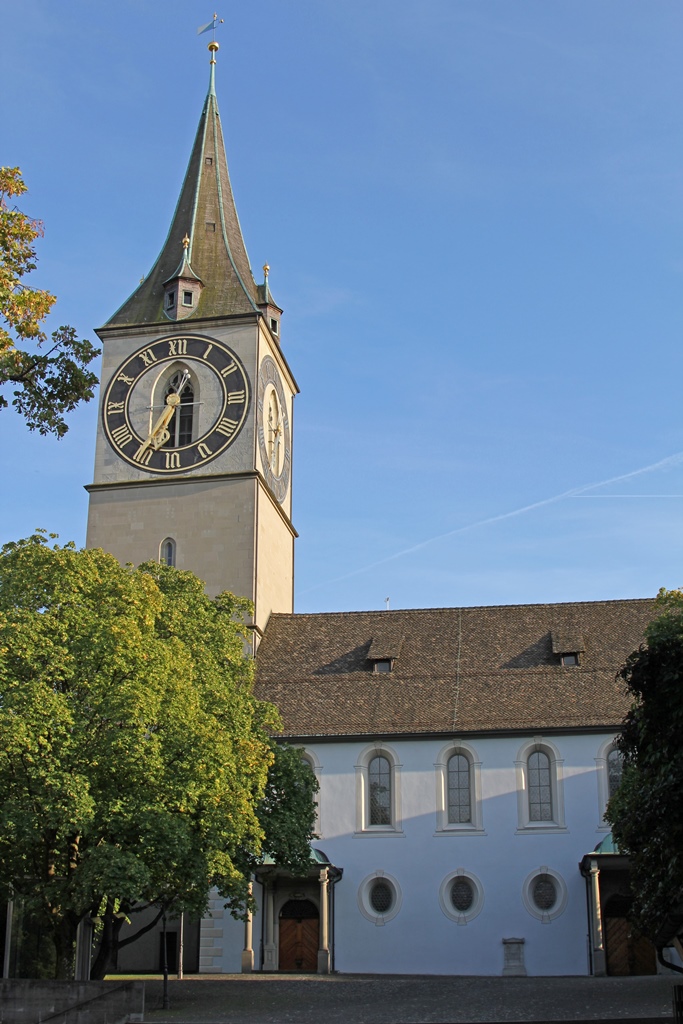
Kirche St. Peter
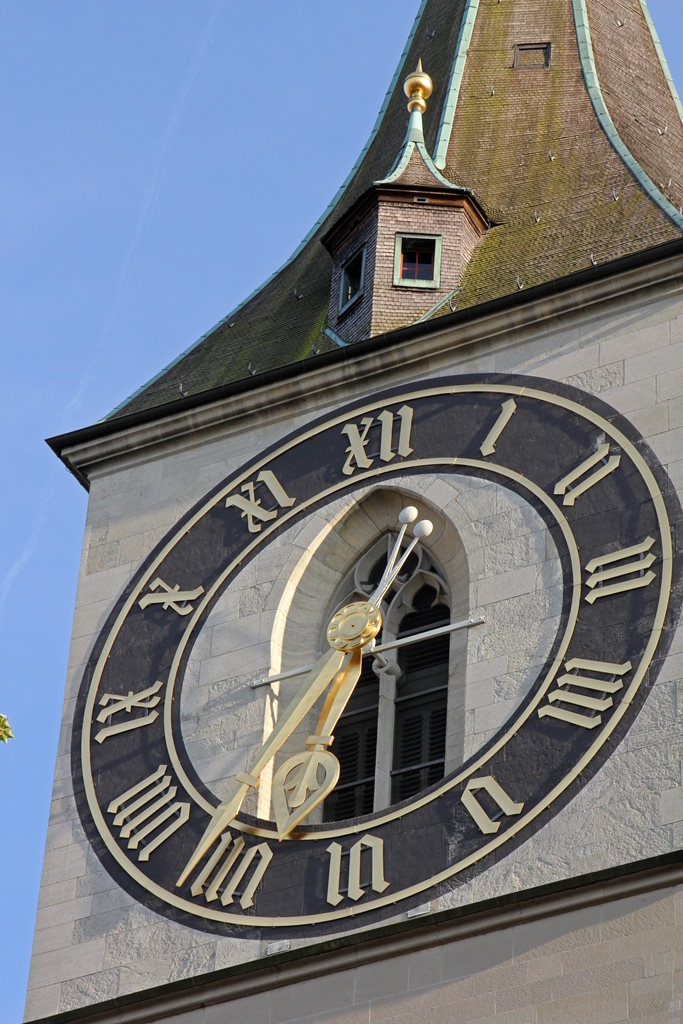
Clock Face, Kirche St. Peter
Seating and Pulpit, Kirche St. Peter
Another church we came across was the Augustinerkirche. This church was
first built around 1270 as the church of an Augustinian abbey. Worship in the
church was discontinued at the time of the Reformation, and for centuries the
church was used for non-religious purposes (e.g. storage, a wine press and a
mint coinage). The church was rebuilt in 1843-44 for use by Zürich's Roman
Catholic community, but when the community rejected the decisions of the First
Vatican Council of 1870, the church was expelled from the Catholic church. At
this time the church became affiliated with the Christian Catholic Church of
Switzerland, a member church of the Union of Utrecht of Old Catholic Churches,
composed of other churches that were also discontented with the 1870 Council.
The church remains in use as a parish church, and was most recently renovated
in 1958-59.
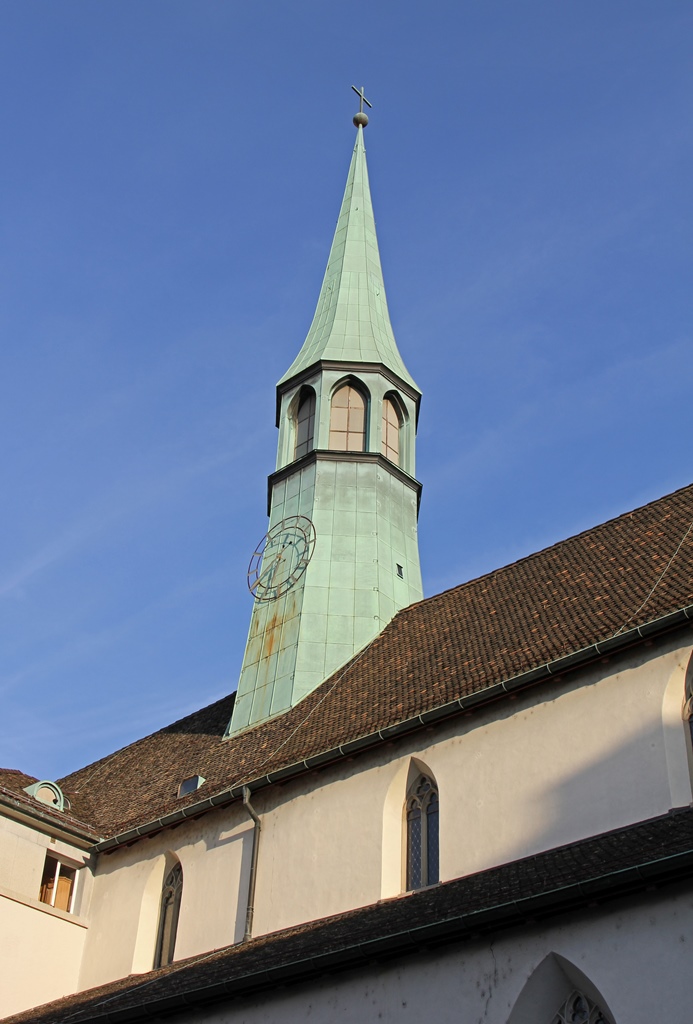
Augustinerkirche
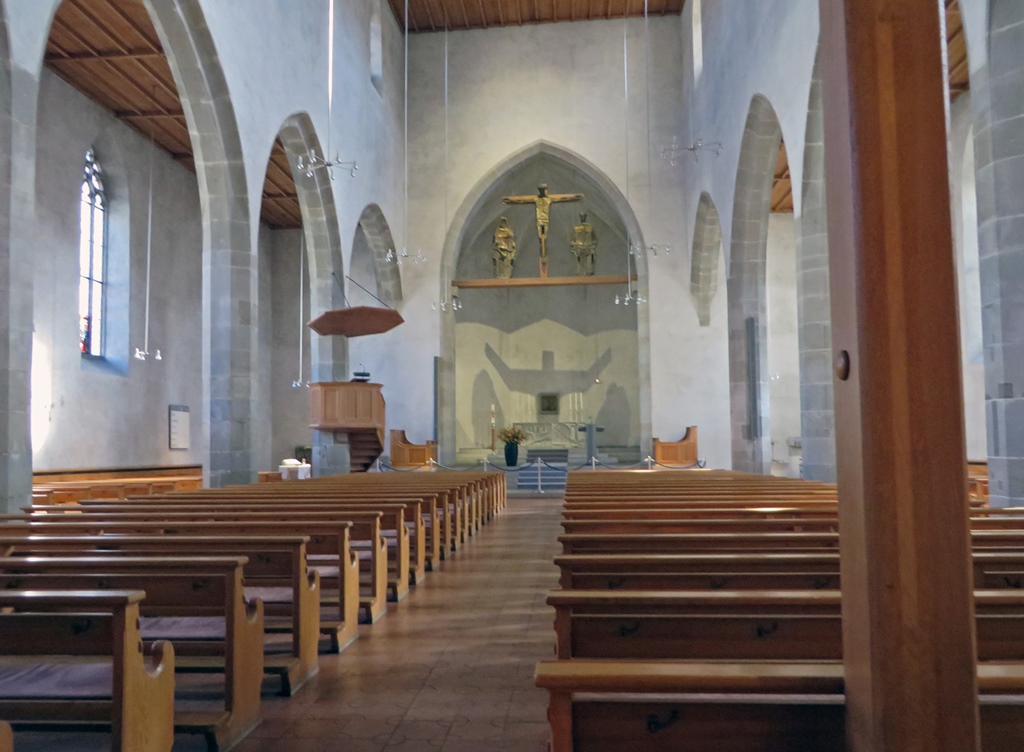
Augustinerkirche
Heading back over to Bahnhofstrasse, we came across Sprüngli's flagship store
at Paradeplatz, a location it has occupied since 1859. Even though we'd had
enough pastries for the day, we went in to look around. The store was much
larger than the one in the train station, and had a bigger selection of items.
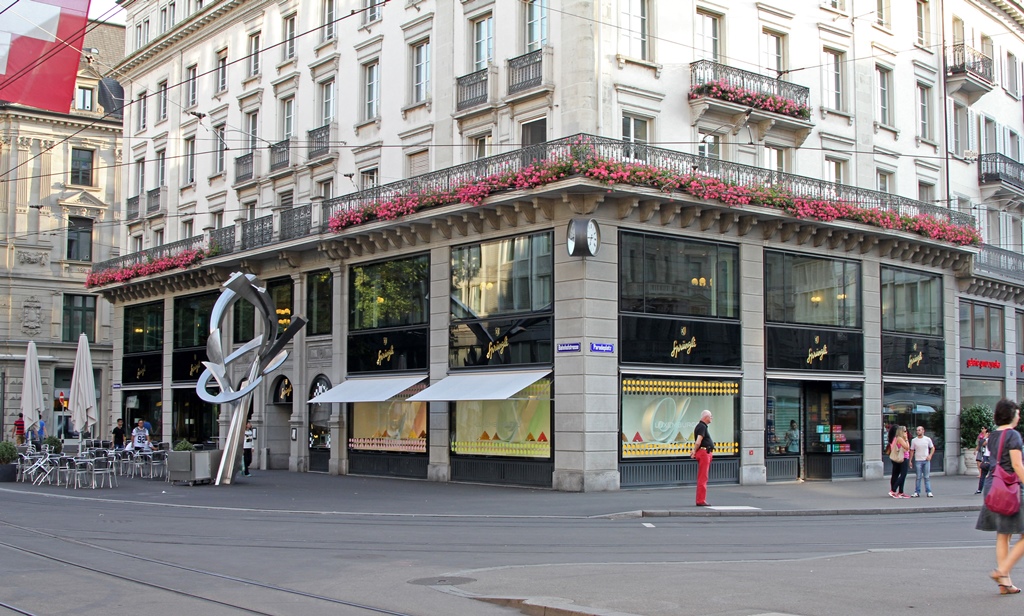
Flagship Sprüngli Store
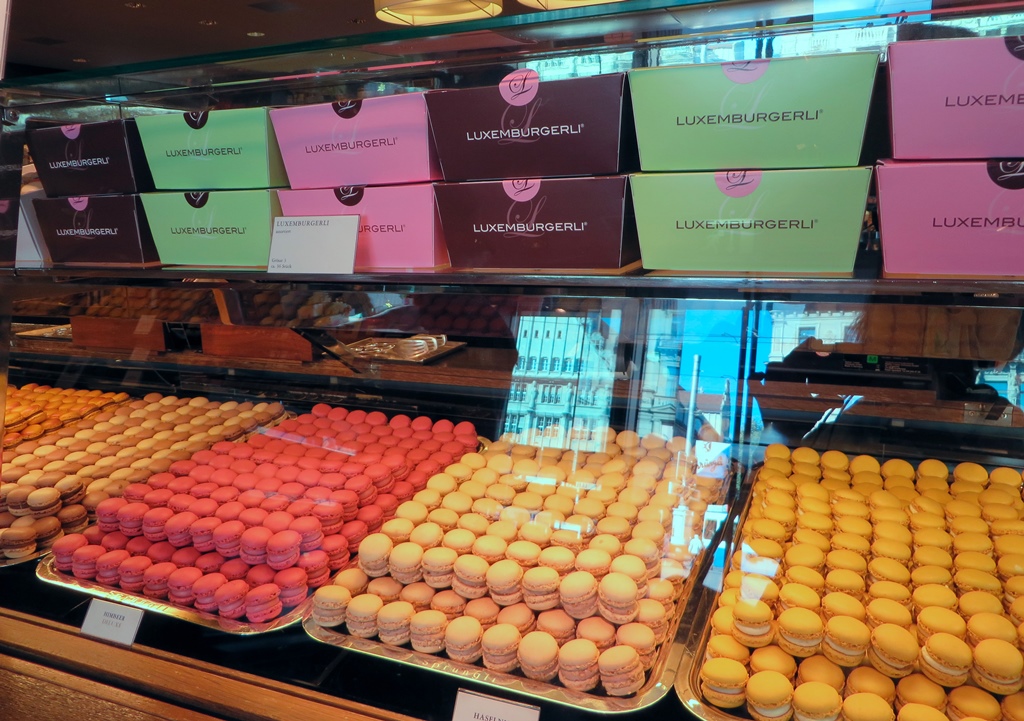
Macarons, Sprüngli Store
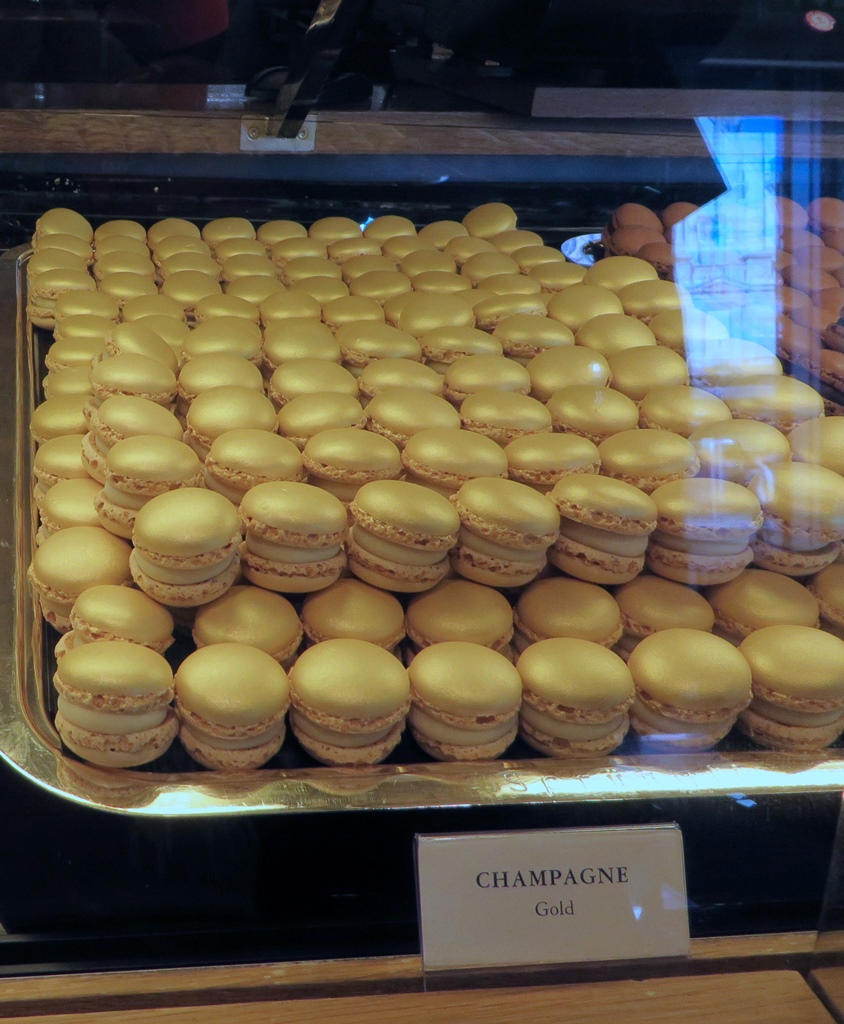
Champagne Macarons
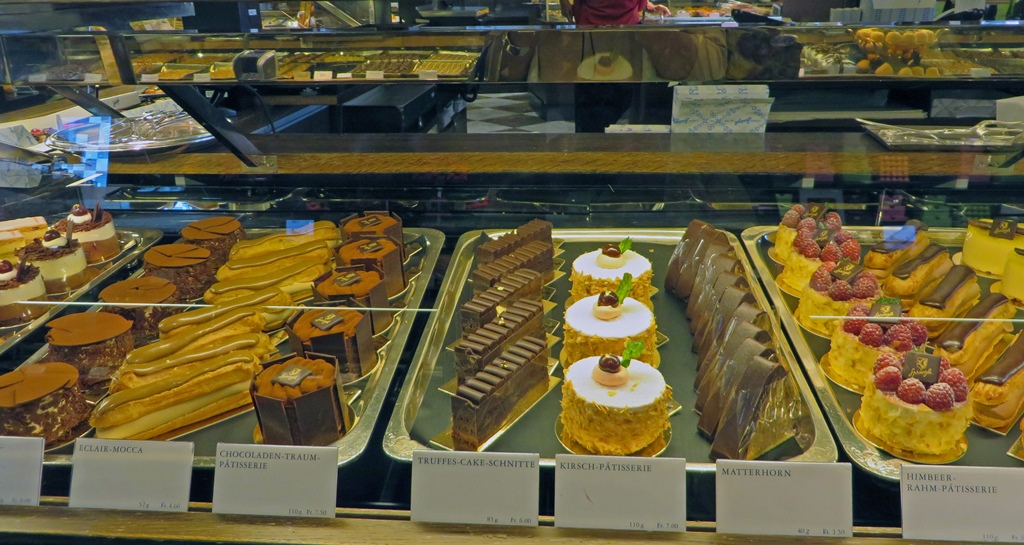
Pastries
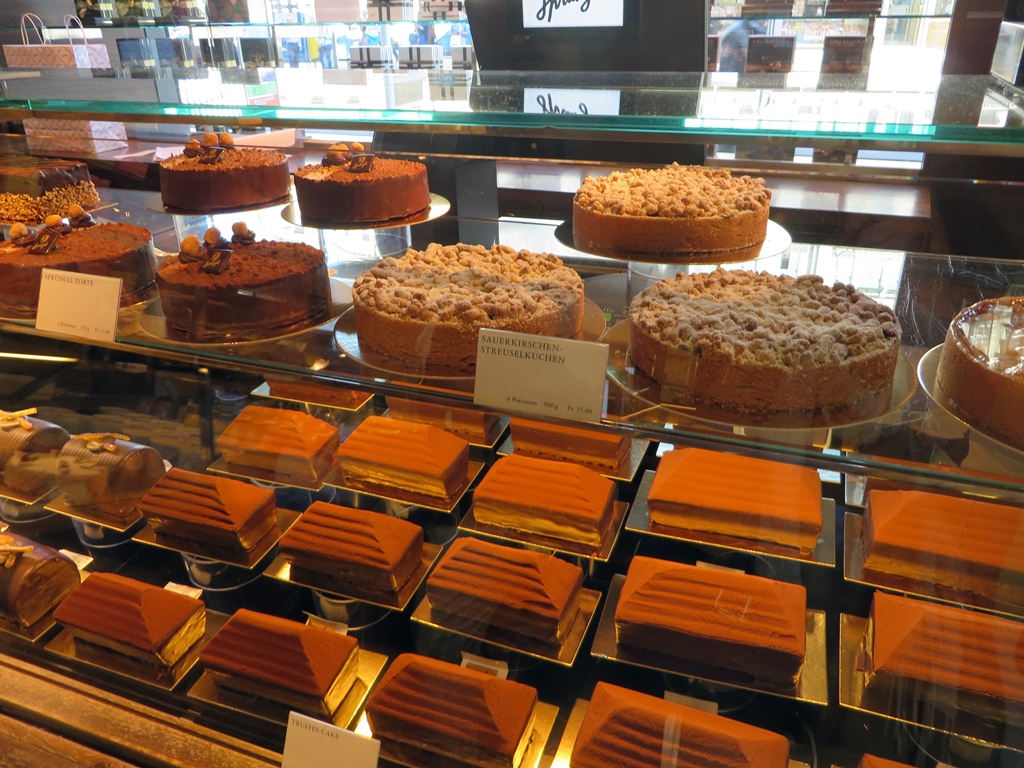
Cakes
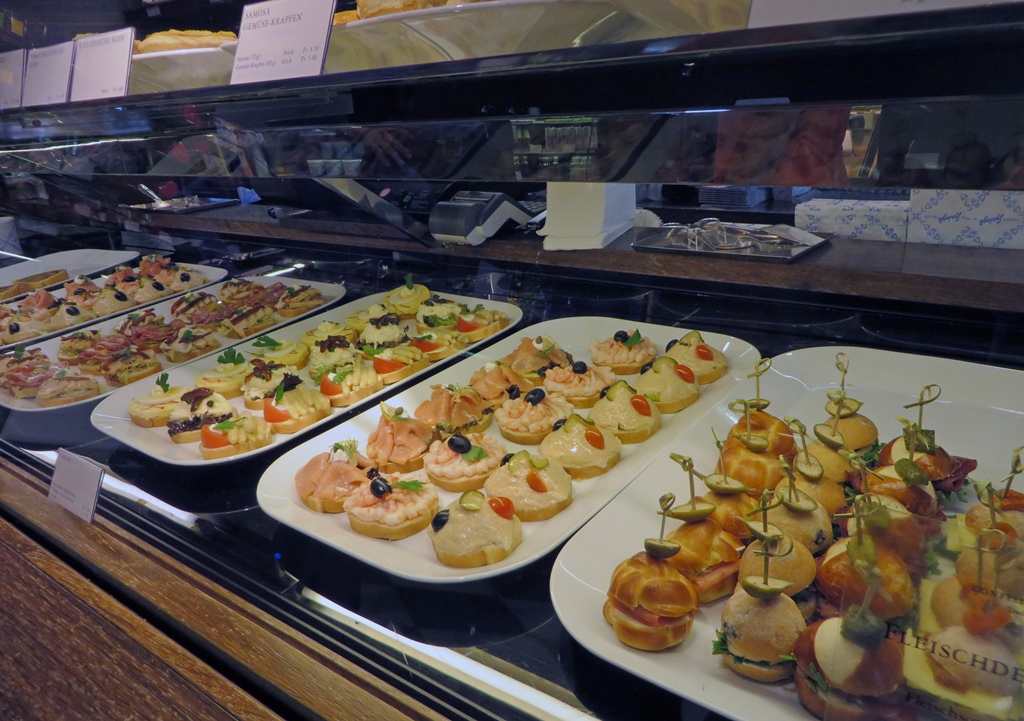
Lunch Food
We spent the rest of the early evening exploring Bahnhofstrasse all the way down
to the lake. The lake looked like it would be a nice place to spend some time,
but it was getting late, so any further exploration of the lake will have to
take place on a future visit.
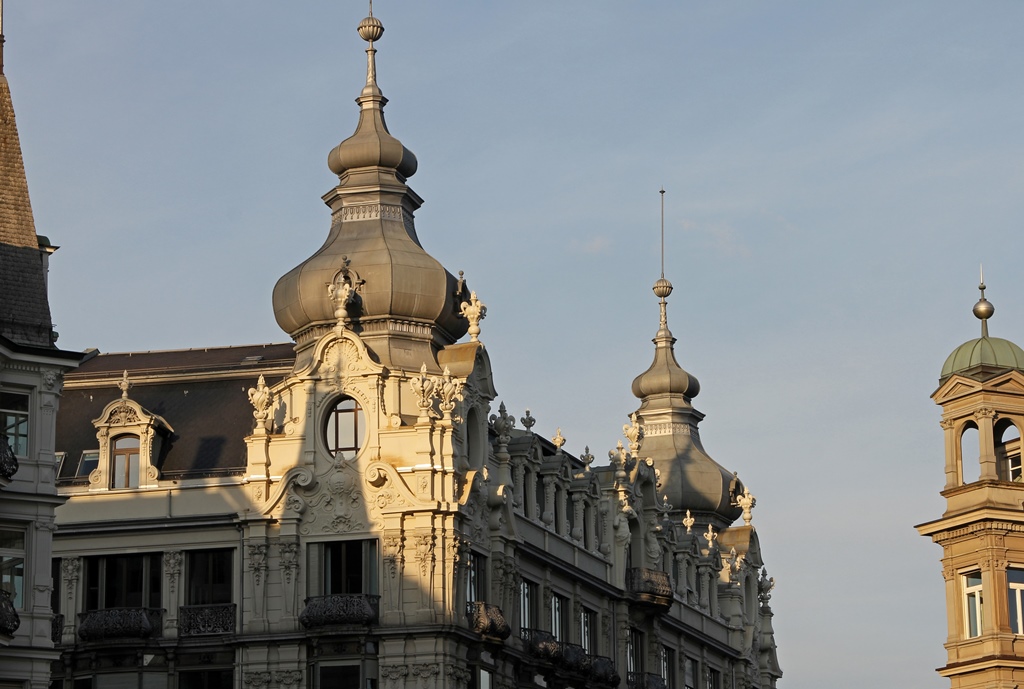
Building on Börsenstrasse
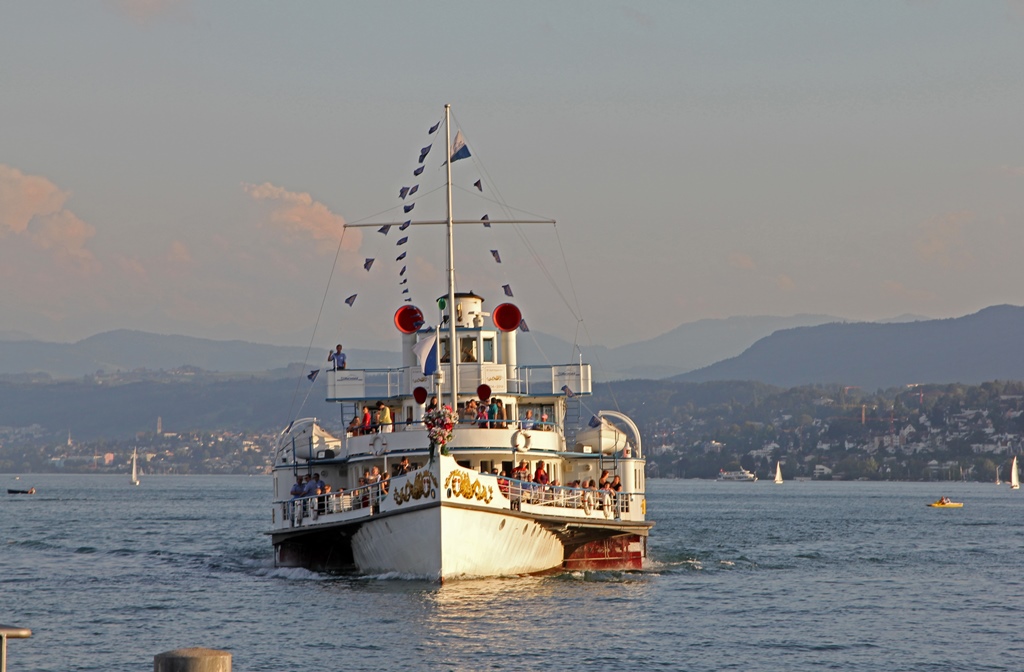
Boat on Zürichsee
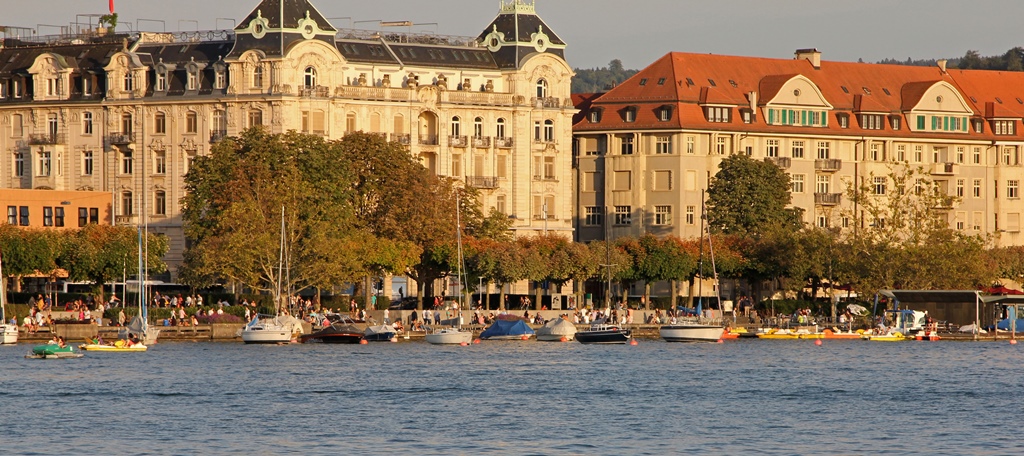
Buildings on Zürichsee
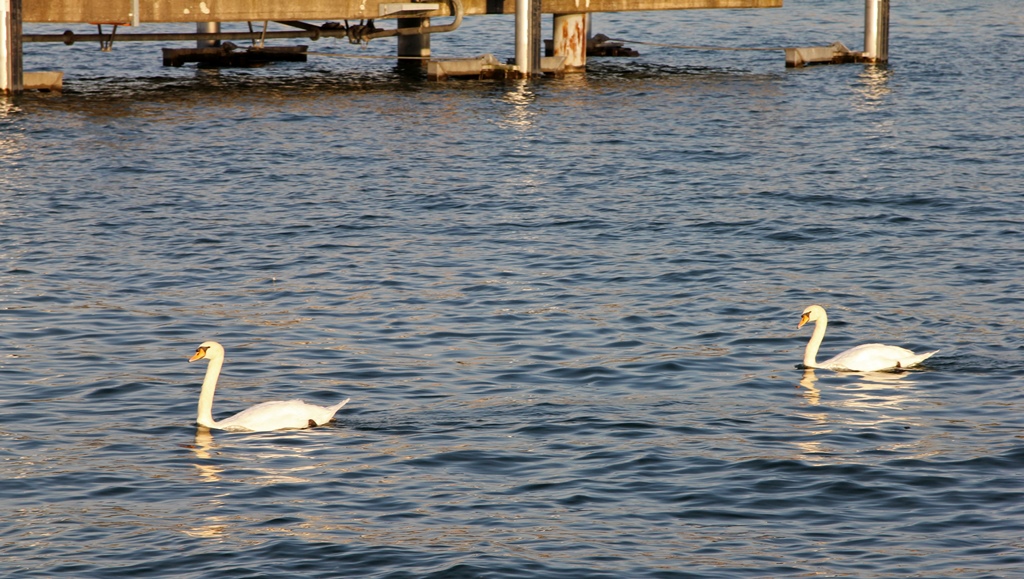
Swans on Zürichsee
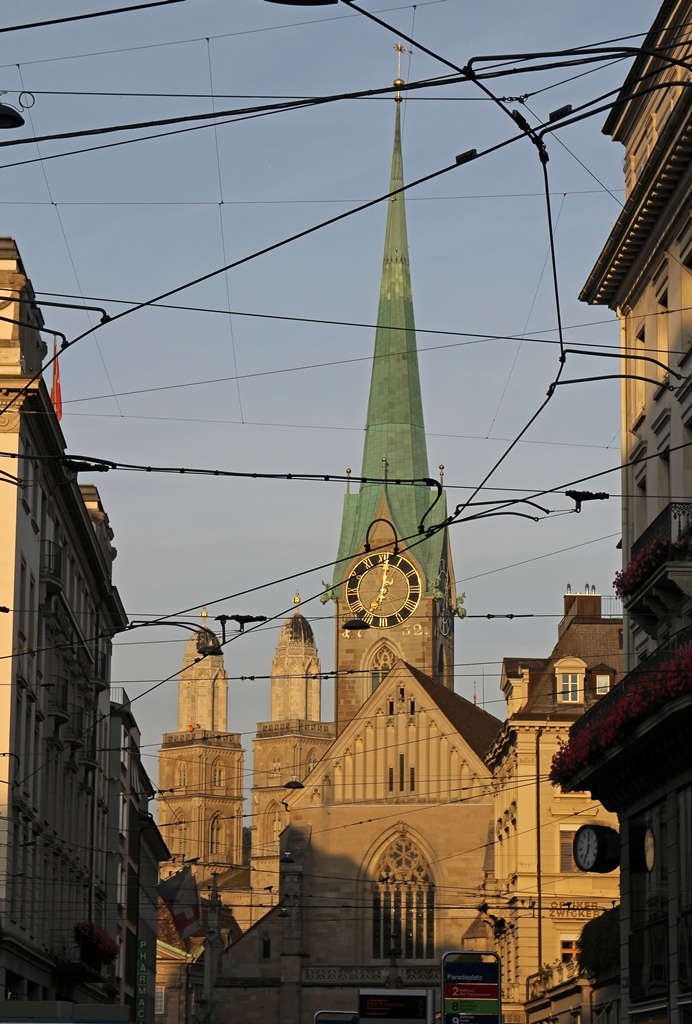
Fraumünster and Grossmünster
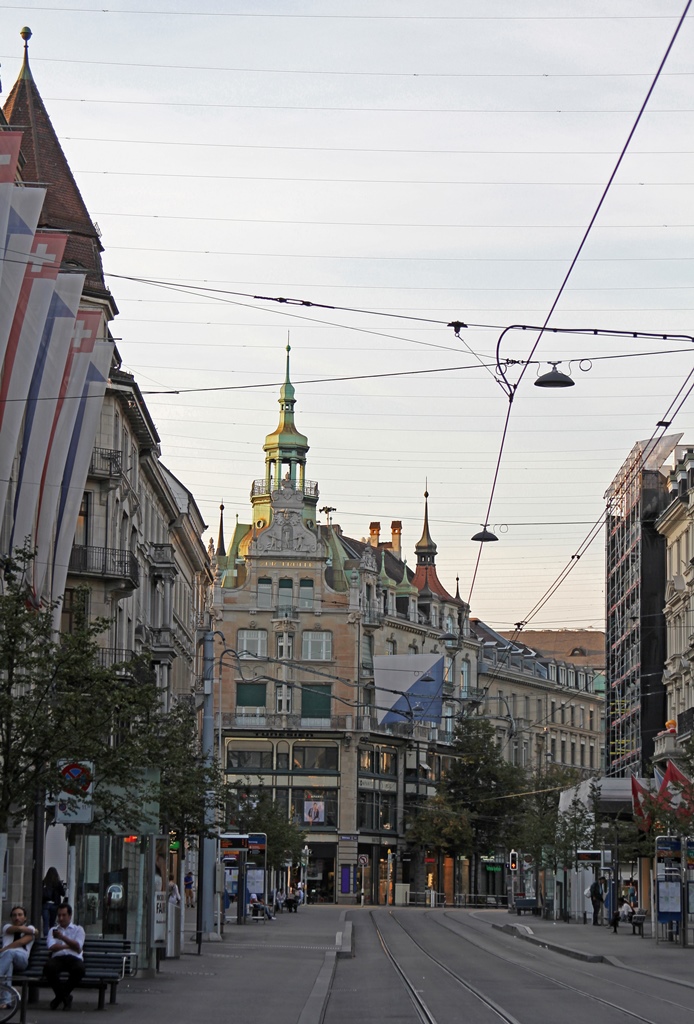
Bahnhofstrasse and Sihlstrasse
Normally at this point I would say something about returning to our hotel
to rest up for the next day's adventures, but first a blank space will have
to be filled in. Between our visit to the Grossmünster and lunch, we actually
squeezed in a visit to what is probably Zürich's top art museum, the Kunsthaus
Zürich. There was a lot of art to see there, and I wanted to devote a full
page to the museum. If you're interested in art, read on…



